
SPECIAL TOPIC


SPECIAL TOPIC
EAGE NEWS Presidential Address
CROSSTALK Decision time for Energy Transition
TECHNICAL ARTICLE Acquiring DAS VSPs in vertical wells

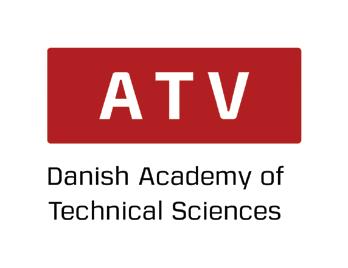
CHAIR EDITORIAL BOARD
Clément Kostov (cvkostov@icloud.com)
EDITOR
Damian Arnold (arnolddamian@googlemail.com)
MEMBERS, EDITORIAL BOARD
• Lodve Berre, Norwegian University of Science and Technology (lodve.berre@ntnu.no)
Philippe Caprioli, SLB (caprioli0@slb.com)
Satinder Chopra, SamiGeo (satinder.chopra@samigeo.com)
• A nthony Day, PGS (anthony.day@pgs.com)
• Peter Dromgoole, Retired Geophysicist (peterdromgoole@gmail.com)
• Kara English, University College Dublin (kara.english@ucd.ie)
• Stephen Hallinan, Viridien (Stephen.Hallinan@viridiengroup.com)
• Hamidreza Hamdi, University of Calgary (hhamdi@ucalgary.ca)
Fabio Marco Miotti, Baker Hughes (fabiomarco.miotti@bakerhughes.com)
Susanne Rentsch-Smith, Shearwater (srentsch@shearwatergeo.com)
• Martin Riviere, Retired Geophysicist (martinriviere@btinternet.com)
• A ngelika-Maria Wulff, Consultant (gp.awulff@gmail.com)
EAGE EDITOR EMERITUS Andrew McBarnet (andrew@andrewmcbarnet.com)
PUBLICATIONS MANAGER Hang Pham (publications@eage.org)
MEDIA PRODUCTION
Saskia Nota (firstbreakproduction@eage.org) Ivana Geurts (firstbreakproduction@eage.org)
ADVERTISING INQUIRIES corporaterelations@eage.org
EAGE EUROPE OFFICE
Kosterijland 48 3981 AJ Bunnik
The Netherlands
• +31 88 995 5055
• eage@eage.org
• www.eage.org
EAGE MIDDLE EAST OFFICE
EAGE Middle East FZ-LLC
Dubai Knowledge Village PO Box 501711
Dubai, United Arab Emirates
• +971 4 369 3897
• middle_east@eage.org www.eage.org
EAGE ASIA PACIFIC OFFICE
EAGE Asia Pacific Sdn. Bhd.
UOA Centre Office Suite 19-15-3A No. 19, Jalan Pinang
50450 Kuala Lumpur
Malaysia +60 3 272 201 40
• asiapacific@eage.org
• www.eage.org
EAGE LATIN AMERICA OFFICE
EAGE Americas SAS Av. 19 #114-65 - Office 205 Bogotá, Colombia
• +57 310 8610709
• americas@eage.org
• www.eage.org
EAGE MEMBERS’ CHANGE OF ADDRESS
Update via your MyEAGE account, or contact the EAGE Membership Dept at membership@eage.org
FIRST BREAK ON THE WEB www.firstbreak.org
ISSN 0263-5046 (print) / ISSN 1365-2397 (online)
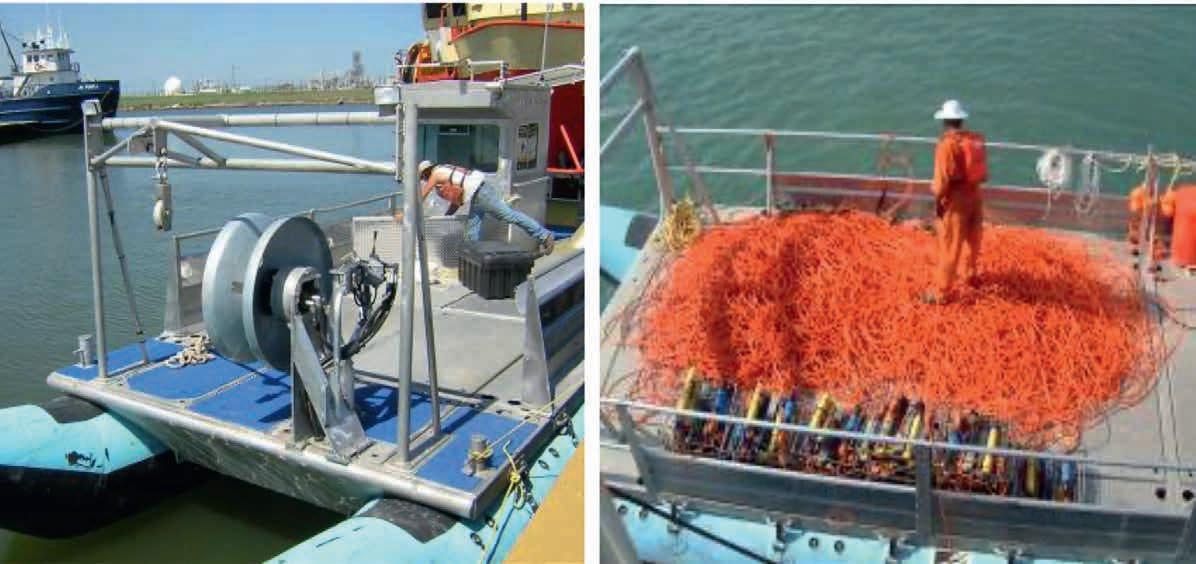
Developments in nodal data acquisition in the transition zone and shallow water
3
23
27 Industr y
35 Progress in acquiring DAS VSPs in vertical exploration wells
Rafael Guerra, Haroon Bajwa, Peter MacLeod, Rigelesaiyin Ji and Bosung Lim
43 A novel approach to predict 3D pressure cubes, Sapphire Field, offshore Nile Delta, Egypt
Mohamed Ahmed Abdelhay, Abdel Nasser Helal, Abdel Aleem Elessawy and Amir Lala
51 Developments in nodal data acquisition in the transition zone and shallow water
Andrew Clark, Jerzy Trela , Piotr Pote¸pa, Sławomir Ziółkowski and Dennis Pavel
57 High resolution mini-3D seismic surveys as a rapid and cost-effective method for detailed structural mapping
Tim Dean, Matt Grant, and Justin Hooi
63 From statics to dynamics: enhancing onshore velocity models with full waveform inversion
Terence Krishnasamy, James Beck and Cristina Reta-Tang
69 Processing on the edge, the evolution of in-field processing in modern land seismic surveys
Amine Ourabah
75 The vibrator and its interaction with the ground
Spencer L. Rowse and Bob Heath
83 The unappreciated importance of Refraction Echoes or Guided Waves in causing bad land seismic data
Christof Stork
89 Land 3D acquisition design: Theory of wavefield sampling.
Part 2: Present 3D design tests for environmentally sustainable sparse perturbed parallel geometries
Bill Goodway, Andrea Crook, Raul Cova, Mostafa Naghizadeh, Michael Hons, Maximo Rodriguez, Cameron Crook and Wendell Pardasie
Feature: Minus CO2 Challenge 2024
101 Student team develops an ultra-deep geothermal (UDG) project with closed loops to produce electricity and heat from Dinantian carbonates, The Netherlands
Maitena Daguerre, Lubin Daumard, Emeline Di Pasquale, Quentin Garcin and Thibault Drulhe
106 Calendar
cover: Sercel’s WiNG node, featuring the ultra-sensitive broadband digital MEMS QuietSeis® sensor, which delivers subsurface imaging (image courtesy of Sercel).
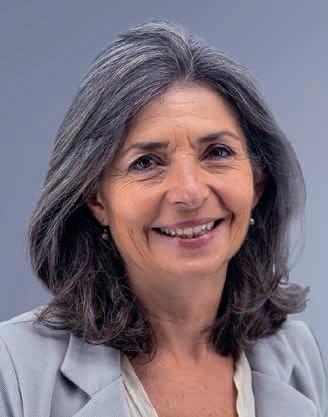

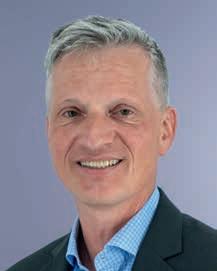
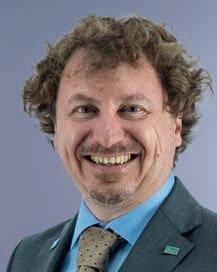
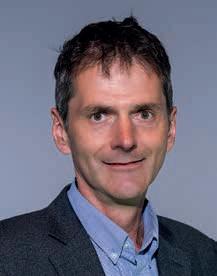
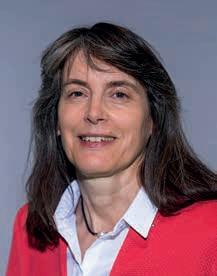

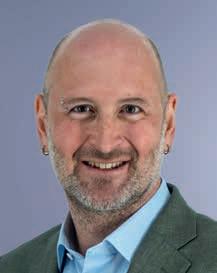
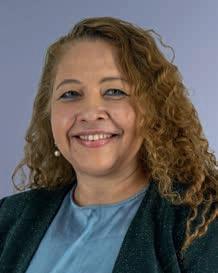
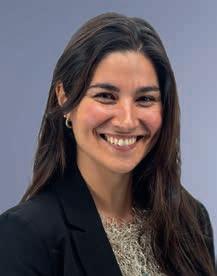
Andreas Aspmo Pfaffhuber Chair
Florina Tuluca Vice-Chair
Esther Bloem Immediate Past Chair
Micki Allen Contact Officer EEGS/North America
Hongzhu Cai Liaison China
Deyan Draganov Technical Programme Officer
Eduardo Rodrigues Liaison First Break
Hamdan Ali Hamdan Liaison Middle East
Vladimir Ignatev Liaison CIS / North America
Musa Manzi Liaison Africa
Myrto Papadopoulou Young Professional Liaison
Catherine Truffert Industry Liaison
Mark Vardy Editor-in-Chief Near Surface Geophysics
Yohaney Gomez Galarza Chair
Johannes Wendebourg Vice-Chair
Lucy Slater Immediate Past Chair
Wiebke Athmer Member
Alireza Malehmir Editor-in-Chief Geophysical Prospecting
Adeline Parent Member
Jonathan Redfern Editor-in-Chief Petroleum Geoscience
Xavier Troussaut EAGE Observer at SPE-OGRC
Robert Tugume Member
Timothy Tylor-Jones Committee Member
Anke Wendt Member
Martin Widmaier Technical Programme Officer
Carla Martín-Clavé Chair
Giovanni Sosio Vice-Chair
SUBSCRIPTIONS
First Break is published monthly. It is free to EAGE members. The membership fee of EAGE is € 80.00 a year including First Break, EarthDoc (EAGE’s geoscience database), Learning Geoscience (EAGE’s Education website) and online access to a scientific journal.
Companies can subscribe to First Break via an institutional subscription. Every subscription includes a monthly hard copy and online access to the full First Break archive for the requested number of online users.
Orders for current subscriptions and back issues should be sent to First Break B.V., Journal Subscriptions, Kosterijland 48, 3981 AJ Bunnik, The Netherlands. Tel: +31 (0)88 9955055, E-mail: subscriptions@eage.org, www.firstbreak.org.
First Break is published by First Break B.V., The Netherlands. However, responsibility for the opinions given and the statements made rests with the authors.
COPYRIGHT & PHOTOCOPYING © 2025 EAGE
All rights reserved. First Break or any part thereof may not be reproduced, stored in a retrieval system, or transcribed in any form or by any means, electronically or mechanically, including photocopying and recording, without the prior written permission of the publisher.
The publisher’s policy is to use acid-free permanent paper (TCF), to the draft standard ISO/DIS/9706, made from sustainable forests using chlorine-free pulp (Nordic-Swan standard).
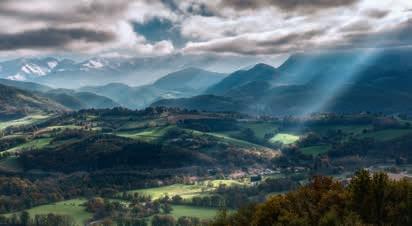


Valentina Socco, EAGE president, welcomes members to a year of opportunity in 2025.
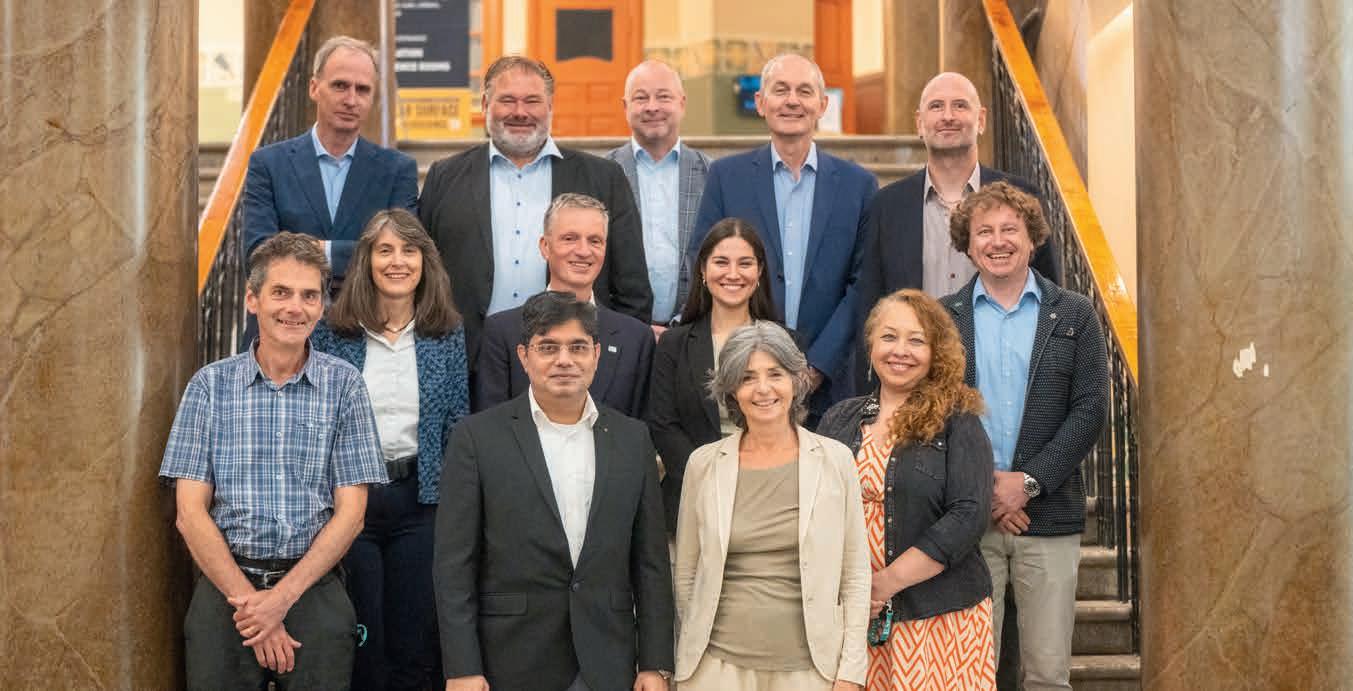
Approaching the end of the year it is natural habit to reflect on the past year’s activities and achievements while looking ahead to future evolutions. Despite the challenging geopolitical situation the world is facing, 2024 has been a successful year for EAGE.
The year witnessed the flourishing of about 60 EAGE events, covering a broad band of established and emerging topics. These were complemented by a plethora of online short courses and e-lectures and a wide set of initiatives organised by Local Chapters. The success of most of these events highlights
the vitality of our community and our Association’s ability to effectively respond to its members’ needs. The 2024 Annual Conference and Exhibition was extremely successful, with a vibrant atmosphere and a strong focus on innovation aimed at tackling the energy trilemma.
In addition, the 5th edition of the Global Energy Transition Conference (GET 2024) in Rotterdam really bloomed this year, attracting six times the number of delegates and exhibitors of the previous editions. This is clear evidence that the efforts and investments in the direction of a more sustainable energy pro-
duction are bearing fruit and are in alignment with evolution of our community, represented by the recently formed Sustainable Energy Circle and related Technical Communities. Your Board is determined to continue along this path and reinforce the efforts toward energy sustainability to offer new opportunities to our longstanding members and attract the interest of new ones.
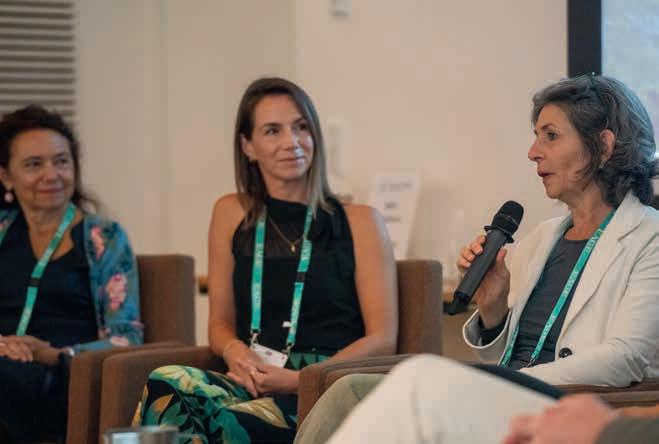
Sustainability, however, goes beyond energy production: infrastructure design and maintenance, raw material supply for green technology, water resources management, resilience to geohazards, and environment protection, are all challenges that have become crucial for a safe development of humanity under the pressure of climate change impacts. Engineers and geoscientists play a major role in addressing these challenges and the Board views the strengthening of activities within the Near Surface Geoscience Circle as a significant opportunity for growth in these crucial areas.
The Board is also consistently and tirelessly committed to maintaining and enhancing diversity and inclusion within our Association. This commitment applies not only to our community and its activities but also, during such a significant phase of transition, to the themes and disciplines we address.



Furthermore, the need to address the topic of communication aimed at society as a whole and the engagement of stakeholders is becoming a key focus. This is particularly important for all activities involving interaction with our earth environment and the subsurface, where engagement of the public is vital. The Board is actively working in this direction by encouraging the creation of events and interest groups that can define high-level communication strategies. This initiative aims to position EAGE as a point of reference not only for the scientific and professional community but also for society and policymakers who require accurate, science-based communication on the complex topics of geosciences.
Improving our ability to communicate the importance of geosciences and engineering will also be able to help attract talent in the younger generation who can bring the passion and creativity that has always characterised our work. We will work, as an association, to support these young talents in their transition to the job market and to provide them with the opportunities that the younger generation deserves.
Most of our achievements and activities would not be possible without the commitment of our members who put their skills, time and energy into the service of the Association. To all these people go our warmest thanks and the deep appreciation of the entire Association and the Board. Our volunteers are supported by the professionalism and commitment of our head office staff, who approach their work with a profound sense of belonging and helpfulness. Our heartfelt thanks go to them as well.
I am personally grateful to the Board members and Board of Directors for their commitment and for the open and constructive attitude that defines the work we are doing together.
I hope to have the opportunity to meet many of you in person during coming EAGE events or at the 2025 EAGE Annual Conference and Exhibition, which will be held in Toulouse from the 2nd to the 5th of June.
I wish to you and your beloved ones a peaceful, creative, and rewarding 2025!























































































































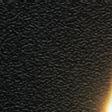


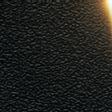















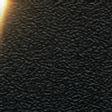













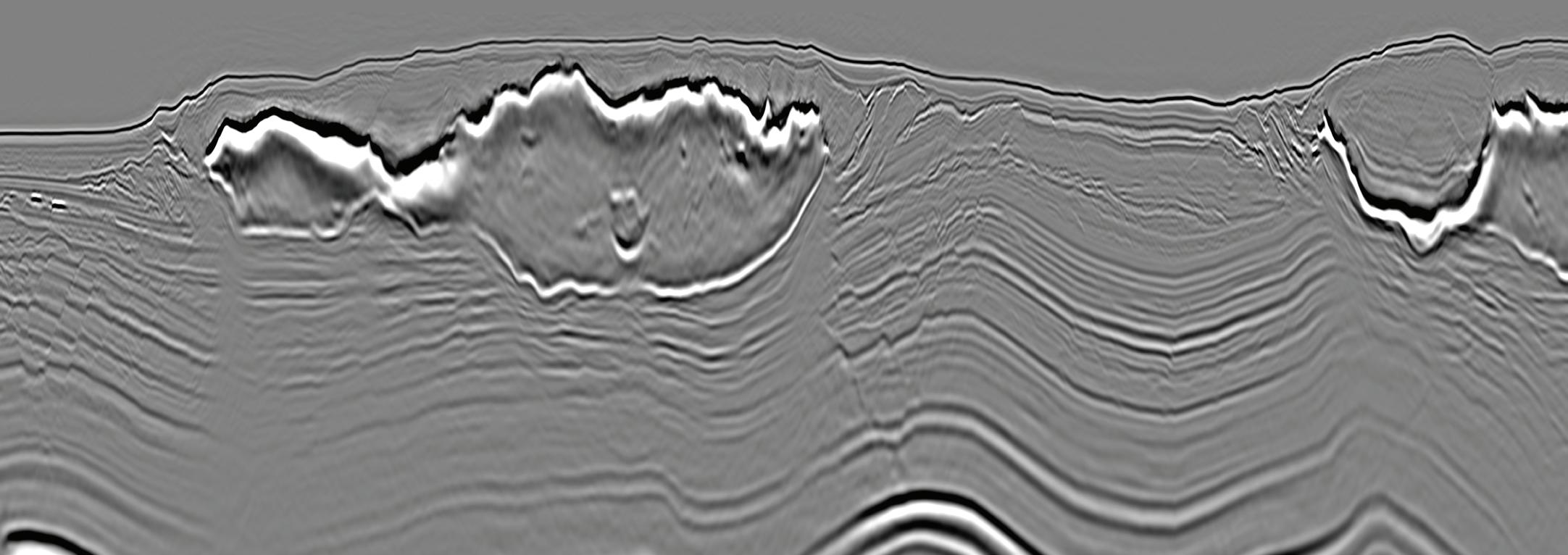
DUG Elastic MP-FWI Imaging solves for reflectivity, Vp, Vs, P-impedance, S-impedance and density. It delivers not only another step change in imaging quality, but also elastic rock properties for quantitative interpretation and prestack amplitude analysis — directly from field-data input. A complete replacement for traditional processing and imaging workflows — we talk the talk and walk the walk!
info@dug.com | dug.com/fwi
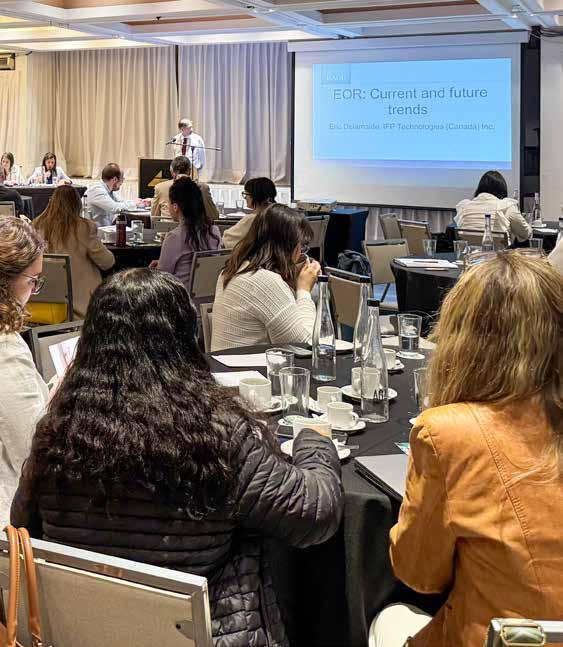
Our latest Technical Community to represent members’ special interests has been formed on Enhancing Hydrocarbon Recovery for Sustainability. It intends to connect geoscientists and engineers working on Improved and/or Enhanced Oil Recovery (EOR/IOR) projects, technologies and carbon footprint optimisation to exchange knowledge and upgrade their skills.
Even though we are embarking on a journey towards the use of sustainable resources, oil and gas will still make up some portion of the energy mix for some time. Therefore, it is imperative that it is produced as cleanly and efficiently as possible. According to committee member, Alan Beteta (Heriot-Watt University), ‘this can be achieved through EOR/IOR techniques, which can recover a larger percentage of the hydrocarbons in place, at a lower water cut and over a
shorter period of time resulting in a lower carbon footprint of the operation’.
As EOR/IOR are technically challenging, Eric Delamaide (IFP Technologies), another committee member, says ‘the new community will be an important platform for sharing knowledge and collaborating to improve project economics and multiply the field projects.’
The EOR/IOR Technical Community will kickstart its activities at the EAGE Annual 2025 with the Dedicated Session ‘EOR During the Energy Transition’. Stay tuned for more details soon. Those interested in being part of the community should update their affiliations at eage.org.
EAGE starts the year with 95 associated societies, including five new cooperation agreements established last year with international professional associations.
Recognising that digital technologies are essential for the advancement of the energy sector, we joined forces with the Society of High Performance Computing Professionals — SHPCP (US).
As part of the mission to connect the HPC and AI user community, SHPCP was invited to participate at the EAGE Annual 2022 (Madrid) and 2024 (Oslo) to lead panel discussions about the cross-sharing of learnings, trends, best practice, and workforce development.
Doug Norton, SHPCP president, said: ‘For the last several years, our society and EAGE have invested in a longstanding relationship and have found it to be a benefit for both organisations.’
Also in the US, we agreed to partner with Geothermal Rising (GR). Since 1972 GR has been advocating for the use of geothermal energy as a crucial
source for the energy transformation. Our partnership will serve to disseminate the latest research, technologies, and applications of geothermal energy.
Expanding our cooperation network in the Middle East, we signed an associated societies agreement with the Kuwait Geosciences Society — KGS (Kuwait) during its inauguration event in early 2024. Dr Mubarak Al-Hajeri, KGS president, said: ‘Looking ahead, KGS is keen to collaborate with EAGE to further enhance practical knowledge in geosciences and engineering, bringing more educational opportunities, workshops, and seminars to the geoscientific community in Kuwait.’
New alliances were also forged in South America. Supported by the Association of Oil, Gas and Renewable Energy Companies in Latin America and the Caribbean — ARPEL (Uruguay), we are connecting with local and international energy companies operating in the region, to share best practice and lessons learned
towards the competitive growth of the industry and its sustainable development.
This cooperation started with ARPEL’s participation at two EAGE events — the First EAGE Conference on South Atlantic Offshore Energy Resources (Montevideo, Uruguay, 2023) and the Third EAGE Workshop on EOR (Buenos Aires, Argentina, 2024). Formal agreement was ratified with our attendance at the ARPEL Naturgas Week 2024 in Cartagena, Colombia.
With the Geological Society of Chile — SGCh (Chile), we are paving the way for leading innovative conversations about the challenges and opportunities of mineral exploration in the region, including the latest advancements and applications in critical minerals, geohazards, geochemistry and hydrogeophysics.
We look forward to collaborating with our associated societies to ensure the continuous professional development of the earth sciences community worldwide.
Message from Marcel van Loon, EAGE CEO.
As the calendar turns, we’re reminded that every new beginning is a chance to set intentions and commit to making an impact.
The global geoscience and engineering community is facing both challenges and opportunities in equal measure. Recent conversations at EAGE meetings including the GET conference have highlighted the worrying trend of geoscience university programmes being discontinued in various countries. This causes a knowledge gap that could hinder the energy transition and broader scientific progress. It is a moment that calls for action to which you can contribute.
EAGE is committed to supporting the next generation of professionals by facilitating the transfer of skills — across sectors, disciplines, and generations. Whether it’s transferring expertise from established energy sectors
to emerging ones, or welcoming skills from other fields, such as communications and data science, our goal is to empower professional journeys towards success and a sustainable future.
This mission is brought to life through the incredible work of you, our members. Year after year, you embrace every opportunity for innovation, making our Association a dynamic and progressive space. Your contributions, alongside the guidance of technical communities and expert volunteers worldwide, help us evolve and expand. New topics are introduced regularly in our conferences, publications, courses and communities to address the most pressing challenges and offer fresh opportunities for engagement. Later this year, for example, geohazards, UXO, and object detection will feature prominently on the agenda of

the EAGE Near Surface Geoscience Conference.
Make it one of your New Year’s resolutions to be part of EAGE. Spread the word and help us make sure no one is left behind. Various support programmes allow current and new members to stay connected, even during difficult times. Meanwhile students can apply for their first year of membership for free and benefit from discounted rates thereafter. Together, we can build a resilient, innovative, and forward-thinking community that’s ready to tackle the challenges ahead.

Calling all geoscience and engineering students: Inspire change, grow your network, and shape your career with EAGE! Renew or start your EAGE Student Chapter today and embark on a journey filled with learning, collaboration, and discovery. As a member of a student chapter, you gain access to EAGE events and webinars at discounted rates or even
for free. These events are designed to enhance your academic journey and professional growth while connecting you with a global network of peers and industry experts.
‘As a student chapter, it is extremely important for us to foster connections with the EAGE community and other student chapters around the world.’ — Best EAGE Student Chapter 2023-2024: Universidad Autónoma del Carmen, México.
‘At the EAGE student chapter, we strongly believe in teamwork and the pursuit of a common goal: to facilitate an enriching transition from student to professional for our members. We invite all students with a passion for geoscience and professionals in the field to join us on this journey.’ — EAGE Student Chapter Universidad Nacional de La Plata (UNLP), Argentina.
With support from the EAGE Student Fund, each new or renewed chapter can apply for 15 FREE memberships to jumpstart activities, ensuring that students from all backgrounds can join the EAGE community without financial barriers. Additionally, EAGE offers funding for grants and sponsorships to support student-led initiatives and local activities. To form or renew your chapter, all you need are four core members – a president, vice-president, secretary, and treasurer – and a commitment to promoting geoscience and energy education within your university.
Scan for more information
Explore an exciting line-up of EAGE events across the world this year. From innovative launches to impactful gatherings, each event brings its own unique excitement. Save your favourites and make plans to join today!
26-28 Feb First EAGE Workshop on Triassic and Jurassic Plays in Northwest Europe Sunbury, United Kingdom
2-4 Apr IOR+ 2025 Edinburgh, United Kingdom
1-4 Sep World CCUS Conference Bergen, Norway
7-12 Sep IMOG 2025 Porto, Portugal
14-18 Sep Seventh International Conference on Fault and Top Seals

Bucharest, Romania
21-22 Oct First EAGE Workshop on Geophysical Techniques for Monitoring CO2 Storage Toronto, Canada CHECK
8-9 May First EAGE Workshop on Land Seismic Acquisition Calgary, Canada
21-22 May First EAGE/SBGf Workshop on Marine Seismic Acquisition Rio de Janeiro, Brazil
9-11 Sep Second EAGE Conference and Exhibition on GuyanaSuriname Basin Georgetown, Guyana
14-16 Oct First EAGE Conference on Challenges and Opportunities in the Future of Mineral Exploration Santiago de Chile, Chile
24-26 Mar 5th EAGE Digitalization Conference and Exhibition Edinburgh, United Kingdom
2-5 Jun 86th EAGE Annual Conference & Exhibition Toulouse, France
7-11 Sep Near Surface Geoscience 2025 (NSG) Naples, Italy
3-7 Nov 6th EAGE Global Energy Transition Conference & Exhibition (GET) Rotterdam, The Netherlands
3-4 Feb EAGE Workshop on Carbon Capture and Storage (CCS) in Basalts Gandhinagar, India
18-20 Feb International Petroleum Technology Conference (IPTC) 2025

Kuala Lumpur, Malaysia
13-15 May 7th Asia Pacific Meeting on Near Surface Geoscience & Engineering Xi’an, China
30 Jun2 Jul 4th Carbon Capture & Storage Conference Asia Pacific
15-16 Oct 4th EAGE/SUT Workshop on Integrated Site Characterization for Offshore Renewable Energy
13-16 Apr Fifth EAGE Well Injectivity & Productivity in Carbonates (WIPIC) Workshop Doha, Qatar
5-7 May First EAGE Atlantic Geoscience Resource Exploration & Development Symposium (AGREDS) Marrakech, Morocco 29 Sep - 1 Oct Eighth EAGE Borehole Geophysics Workshop Al Khobar, Saudi Arabia 10-12 Nov Seventh EAGE Rock Physics Workshop Cape Town, South Africa 24-26 Nov
Kuala Lumpur, Malaysia
Melbourne, Australia
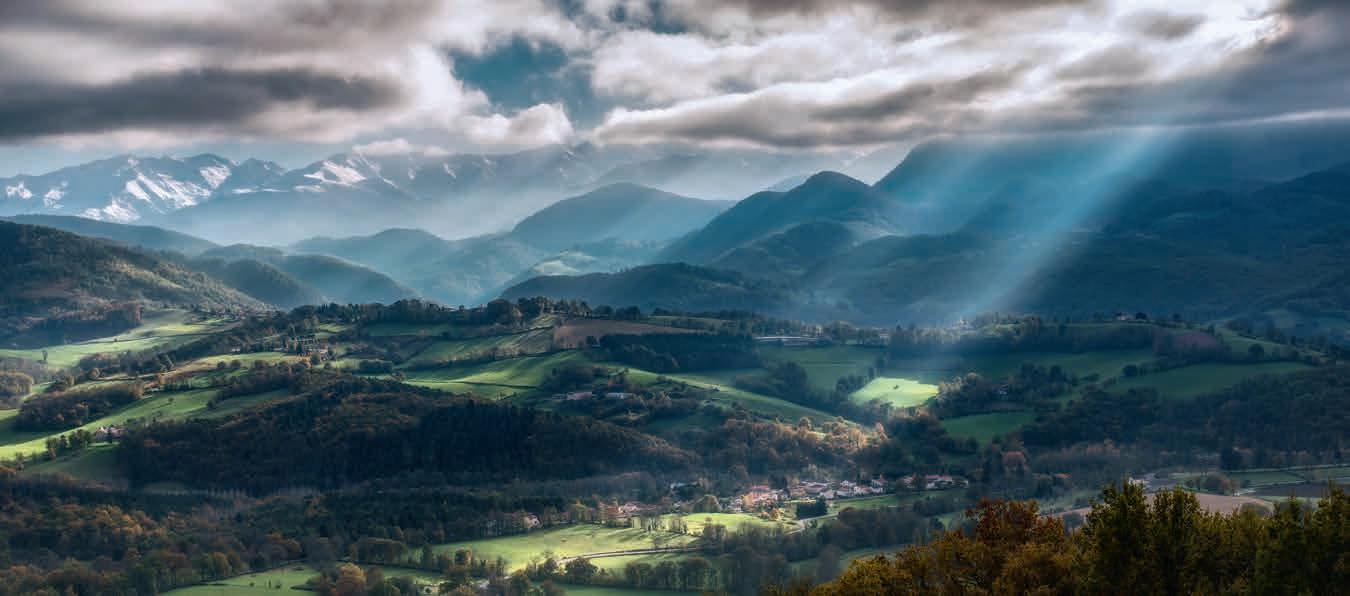
Five field trips, lasting from half a day to two days, are being planned for this year’s Annual in Toulouse, and as ever they will be a major addition to the programme of events.
World-renowned for its aerospace industry and pioneering companies in health, biotechnology, nanotechnology, and robotics, Toulouse and its surroundings offer a fantastic playground for field trips. From delving deep into the earth at the core house in Boussens to reaching for the stars at the Cité de l’Espace, these
field trips will connect participants with both natural and engineered solutions for energy challenges.
Outcrop visits will also allow delegates to experience the beauty of the Pyrenees up close while exploring ‘natural hydrogen potential’ and ‘clastic and fractured reservoir analogues’.
EAGE Annual field trips are designed to inspire and provide a rich, hands-on learning experience where practical knowledge meets the local landscape. Each itinerary underscores
the critical role of integrated disciplines, such as geoscience, reservoir engineering, and technological innovation, in achieving sustainable transition goals. These experiences also offer a unique opportunity to build connections and expand knowledge in an immersive environment.
With limited spots available, interested participants are encouraged to register early to secure their place. Visit eageannual.org/field-trips to learn more details.

There’s no doubt about it. Our GET 2024 Conference and Exhibition in Rotterdam in early November — the fifth in the series — was an outstanding success. It demonstrated that the geoscience community is eager to meet the challenges of energy transition and has the tools to accelerate the process.
Fifteen hundred participants, by far the largest attendance to date, were treated to our most ambitious programme yet, founded on separate conferences on CCS, Geothermal, Hydrogen, and Offshore Wind Energy plus a Strategic Programme linking the many issues involved in energy transition policy, business and technology.
Yolande Verbeek, chair of GET 2024 and COO of EBN, probably best summed up how the week transpired: ‘The beauty of this conference lies in its technical pillars and programmes, which give people the option to dive deeply into their own technology while also stepping out of their bubble to explore other technologies, making cross-sharing of knowledge truly effective here.’
The quality and tone of the conference was set by the two excellent opening Ted Talks style addresses by Floris Alkemade, an architect, urban designer and well-known public speaker, on the transformative power of innovation and Remco de Boer, Dutch energy analyst and podcaster, on Europe’s vulnerability in the global energy transition. Between them they offered contrasting visions of hope and realism. Alkemaden talked inspiringly about the ‘survival pattern’ which marks human history. In his optimistic view ‘imagination trumps technology’ and will be key to change as it has been in the past.
Taking a different tack, de Boer claimed that Europe was too focused on energy transition and needed to change course. The gist of his argument was that EU countries have a good record on curbing emissions and take-up of renewables on a global basis, but net zero targets come at a cost, e.g., continuing reliance on energy imports, lack of criticial minerals, high price of natural gas compared with US and Asia, and decline in manufacturing (itself a cause of falling emissions). To sustain its energy transition goals, de Boer argued that the EU must focus more on having a strong economy.
In a nice recognition of the future faced by the next generation of geoscientists, the Opening brought on stage the student winners of the Minus CO2 Challenge (UniLaSalle, France) and the Marie Tharp Sustainable Energy Young Professionals Award (Samuel Zappalà, Uppsala University) to receive their prizes.
Just what went down in each conference is impossible to summarise here, but feedback has been overwhelmingly positive. Predictably, the CCS programme captured the most attention, this time featured business value chains; the Geothermal programme highlighted advances in the Netherlands but also discussed the
global perspective such as Oman’s Vision 2040; Hydrogen and Energy Storage discussed ongoing pilot activities reflecting growing confidence in the technical feasibility of these initiatives; Offshore Wind Energy talks spanned topics such as geohazards, offshore wind case studies, object detection methods including UXO, seismic data processing, and innovative approaches to ultra-high-resolution (UHR) seismic inversion.
The conference programme was bolstered by the Strategic Programme notable for its emphasis on collaboration across sectors exploring topics like digitalisation, resilient value chains, and public engagement. Throughout the event, the Exhibition area and the EAGE’s own Community Hub provided a continuous focus for engagement and animated discussion. Meet & Greets by the EAGE Sustainable Energy Circle and Local Chapter Netherlands were a highlight. Sessions by Women in Geoscience and Engineering and Young Professionals continued the work of promoting the

Panel discussion at the Opening.
importance of diversity and fresh talent in the energy transition. Student attendees were well catered for with an enthusiastically received four-day Energy Transition Student Days led by industry experts Raymond Franssen (Synergeo) and Manuel Willemse (Utrecht University).
Beyond its main programme, GET 2024 included workshops, short courses, and field trips. A standout was the Porthos Project tour, showcasing CO2 capture from industries in the Port of Rotterdam and its storage in depleted North Sea gas fields.
Social activities maintained the energy of the meeting with a Speakers’ Reception at Rotterdam City Hall, a lively Icebreaker Reception and a Conference Evening aboard an iconic Holland-America Line cruise ship which brought 850 attendees together to enjoy restored decks, stunning harbour views, lively entertainment, and exceptional cuisine.
We will be back for GET 2025 at the same venue in Rotterdam on 3–7 November 2025. Stay informed and updated by visiting eageget.org.

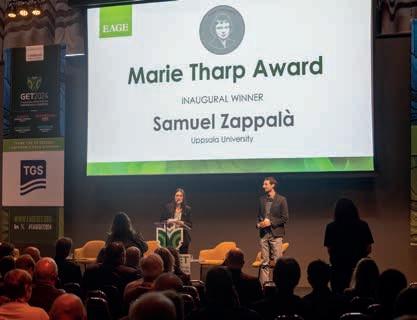
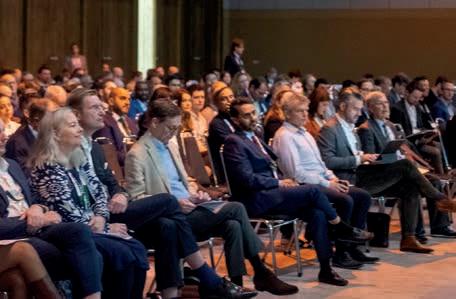


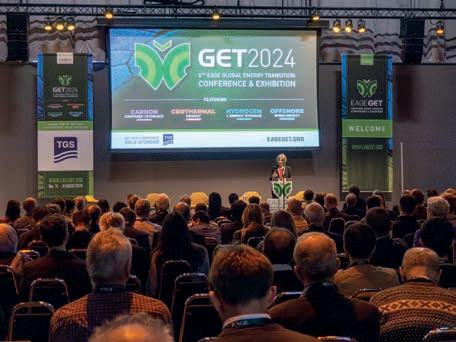
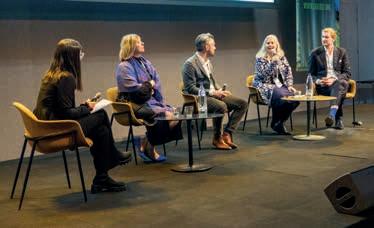
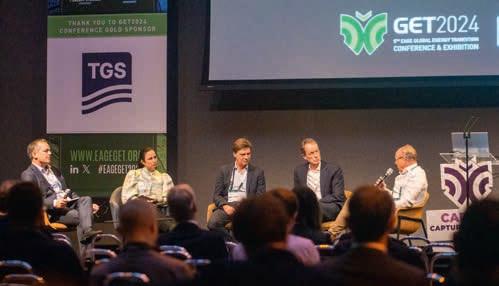
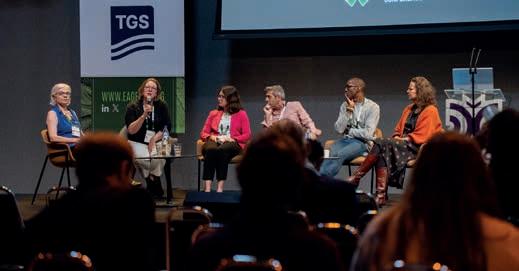
Insightful presentations on CCS, hydrogen, wind, and geothermal innovations ignited engaging discussions.
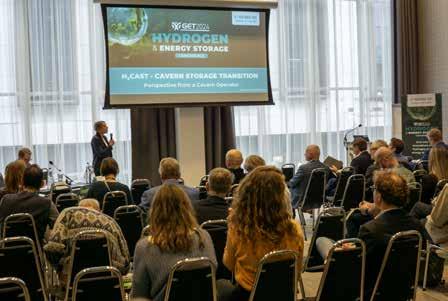

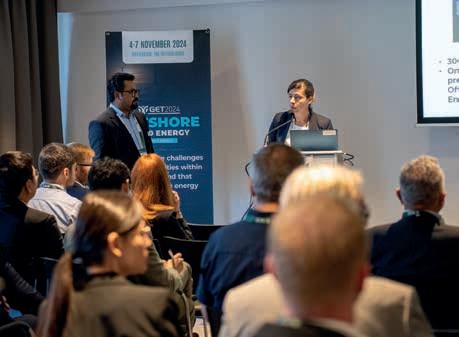
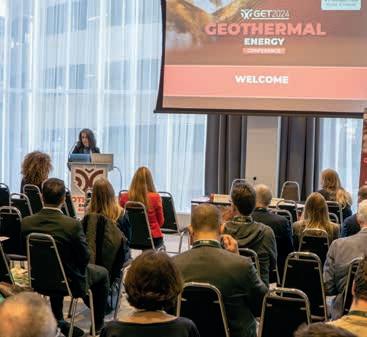
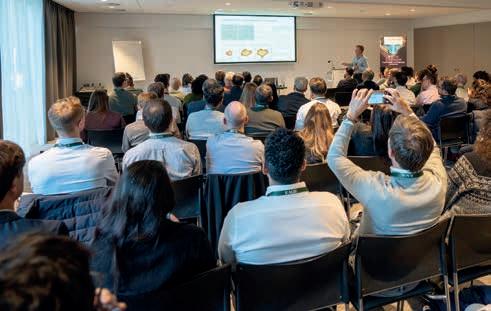
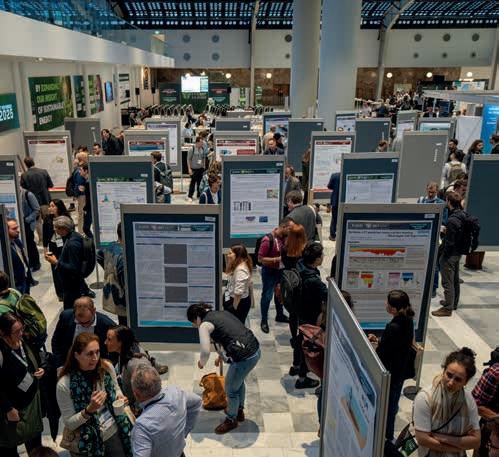
Getting to learn from peers through workshops, short courses, field trips, and exhibition.
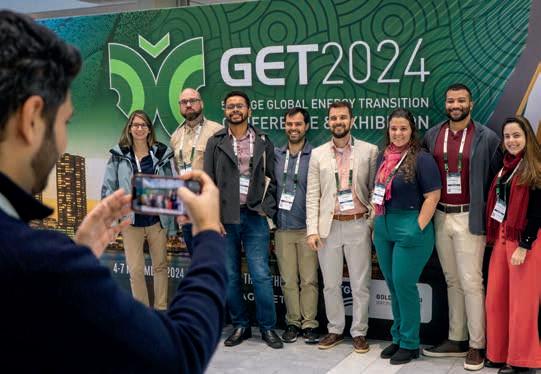
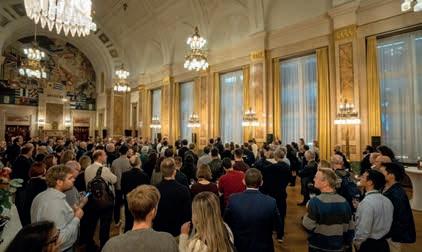

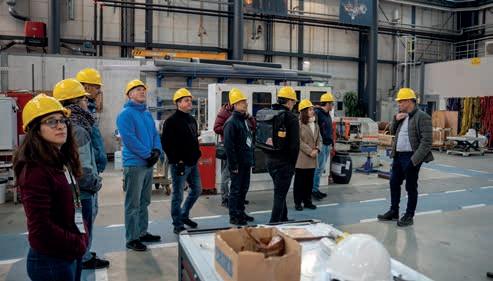

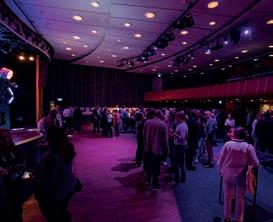
EAGE offered a short course on Geoscience Communication and Public Engagement led by Professor Iain Stewart during GET 2024 held in November in Rotterdam. Emer Caslin, business development manager at iCRAG, offers this review of the course which underscored the importance of communication skills in fostering trust, securing project approvals, and bridging the gap between technical expertise and public understanding.
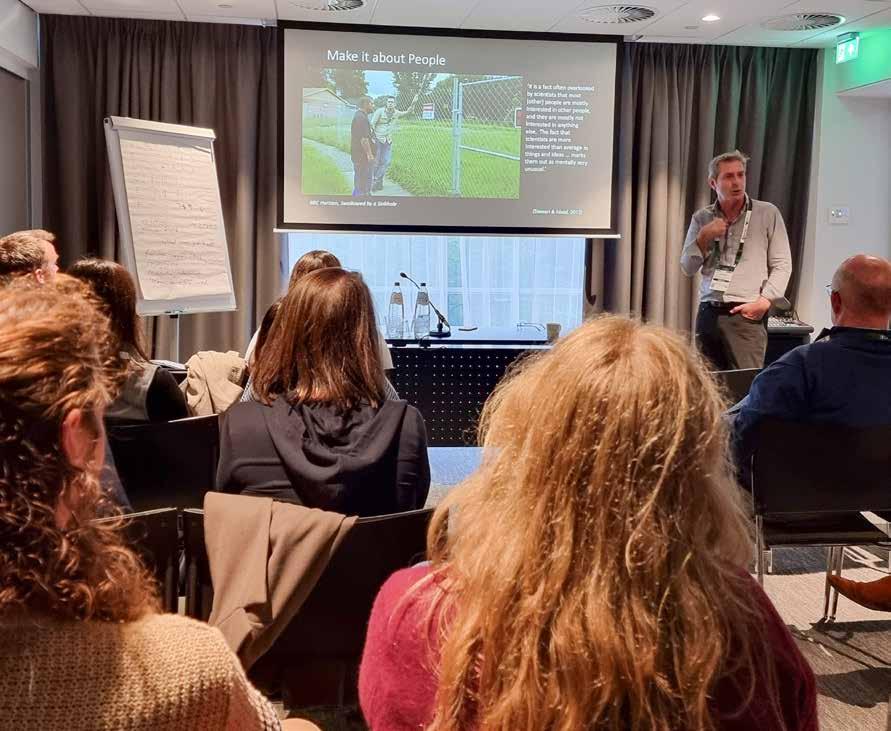
While there is a growing consensus that engagement with the public is of crucial importance for project enablement and to enhance the reputation of geoscience, we as a discipline, as a sector, are poorly equipped to address this. Every panel session, article, and podcast emphasises the critical importance of effectively commu-
nicating the science of our subsurface to drive the low-carbon energy transition but our current toolkits fall short in providing these essential skills.
The short course on geocommunication offered attendees an excellent introduction to the subject, serving as their first opportunity to explore it. Prof
EAGE is committed to fostering these critical skills among geoscientists. Building on the momentum from GET 2024, plans are underway to include this inspiring course at the EAGE Annual 2025, ensuring more members can benefit from Prof Stewart’s insights.
By prioritising communication, geoscientists can not only dispel misconceptions but also foster trust and collaboration with stakeholders, securing the social license to operate. Together, we can transform the way geoscience connects with society, paving the way for a sustainable energy future.
at the EAGE Annual 2025
Stewart didn’t hold back on delving into the science of communication and its evolution over the past 40 years from deficit to dialogue through to participation models. We discussed the process of engagement through a model adapted from disaster risk communication, which is broadly applicable to all engagements where the public becomes part of the solution, rather than the problem, through guided and co-created communication.
The course equipped us with tools and techniques to be better communicators from simply reframing how we address our audience based on who is in the room to practical exercises using techniques such as the communication bowtie, the Freytag pyramid, the three act structure and audience segmentation. Prof Stewart weaved in and out of communication theory and visual, resonant application of geoscience. Frequently incorporating funny examples from pop culture, the course takes us outside of ourselves to show we are rarely the ‘rock stars’ we think we are and often reduced to the bottom shelf of a bookstore analogy where so many other topics in the public domain trump geoscience.
Prof Stewart is passionate about the power of storytelling. Geoscience is so vast and visual that it can really capture awe and wonder and bring the public in, in a way no other science can. Human-centred stories will always resonate more and the course underlines the pivotal importance of understanding the human psyche. As scientists, we have a distinct way of looking at things and this means we are often outliers when it comes to public perception. Prof Stewart takes us through examples of a range of subsurface projects (fracking, CCS, geothermal, etc.) where opposition was rarely about the science. There is a need to shift our focus from ‘matters of fact to matters of concern’ and get a

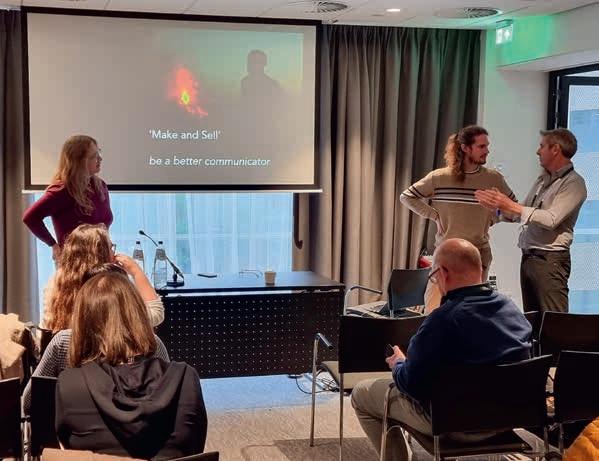
better handle on risk psychology; what is behind the public outrage that can threaten project execution and how can we better address this risk?
One slide that focused on risk perception for CCS was particularly telling about public misconceptions of the subsurface. One finding revealed that nearly half of the public surveyed on this technology believed that injecting CO2 into the subsurface ‘is like pumping up a huge balloon underground’. A clear example of why public perception poses such a significant risk.
The slide should perhaps have been shared with the participants on the parallel course on CCS risk assessment that morning!
This course proved an ideal way to conclude GET 2024. We left the room that Friday evening feeling inspired, invigorated, convinced of the growing importance of geocommunication skills and eager to learn more. There was a sense of empowerment by attendees to be able to take back control of our narrative by communicating as individuals rather than corporations.
Our CO2 Storage Masterclass is back, this time in Utrecht, Netherlands, from 11-14 March 2025 providing another opportunity for professionals worldwide with a comprehensive programme on geological CO2 storage, a cornerstone of the energy transition.
The 2024 event featured three intensive courses led by renowned experts Philip Ringrose, Andreas Busch, Eric Mackay, and Florian Doster with participants praising the technical depth and practical applicability of the sessions, with one stating, ‘It was an eye-opening session on CO2 migration and mechanisms, especially useful for monitoring and planning.’
For the 2025 edition, the programme in Utrecht will continue to offer a focused learning environment, addressing the critical aspects of CO2 storage. This time, a new course by Martin Landrø on Geophysical Monitoring of CO2
Participants from the 2024 edition highlighted the unique value of the Masterclass’s interactive format and its role in fostering connections. One attendee remarked, ‘The interaction with others is a real value. You can’t beat that.’ Another lauded the course for offering ‘a good state-of-the-art understanding of
CO2 storage risks, invaluable for project planning’.
Mark your calendar for 11–14 March 2025 in Utrecht, and stay tuned for more details on this Masterclass.
For more information
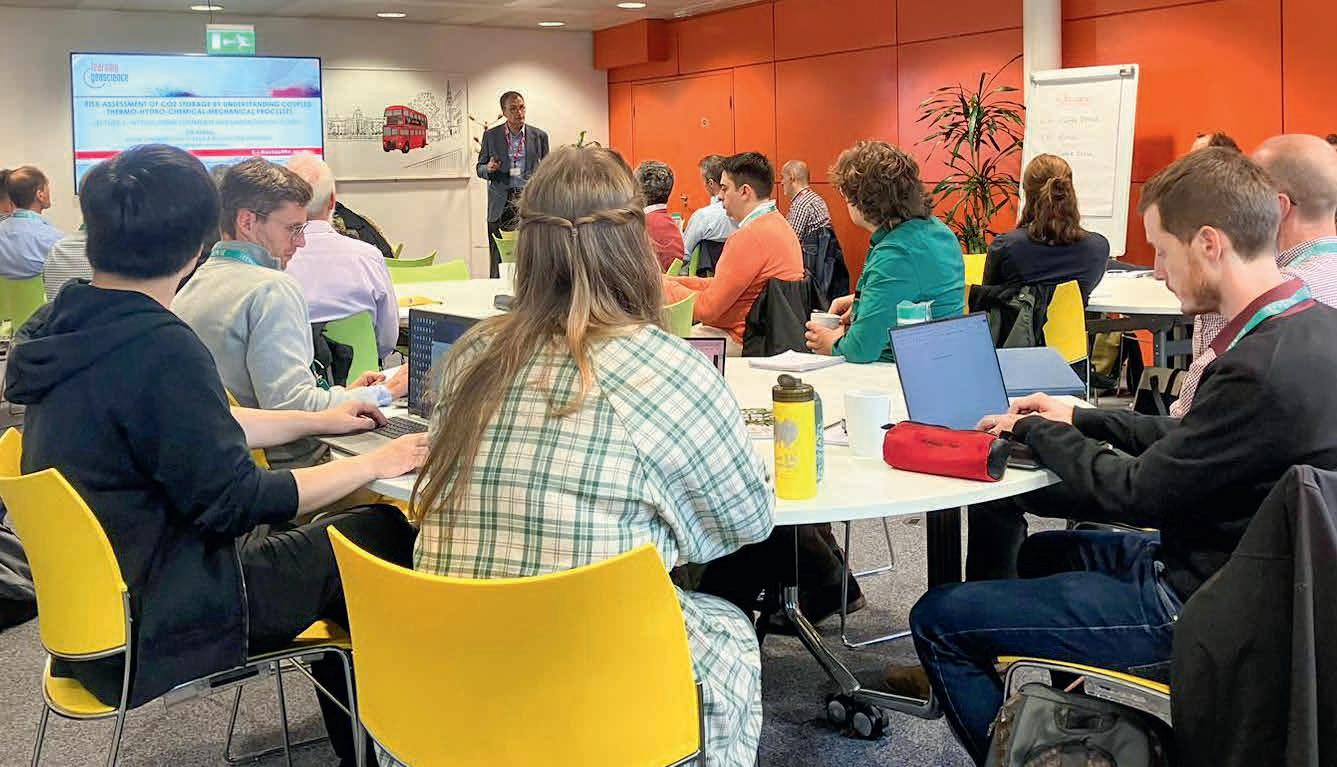


EAGE Digital 2025 in Edinburgh from 24-26 March hosted by BP is set to be a landmark event showcasing the transformative power of digital technologies in energy. Once again, the event will feature a range of dedicated sessions highlighting the latest developments and applications in the digital sphere.

Participants can choose from numerous topics:
Digitalization for Geothermal and CCS: How digital solutions can reduce costs, streamline processes, and contribute to sustainability goals.
Generative AI applications in dayto-day environment - Use cases, benefits, and challenges: Focus on challenges in adapting AI to specific problems,
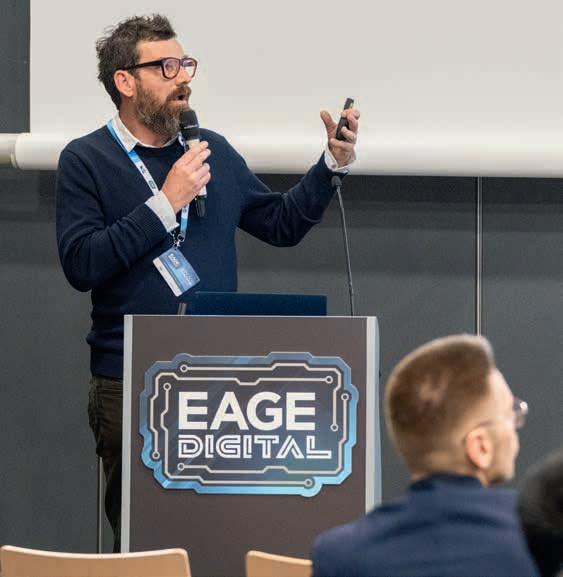
ensuring data security, and evaluating the value of AI solutions with real world examples.
Data driven production forecasting: With machine learning and hybrid models enhancing forecasting accuracy, case studies will demonstrate the integration of advanced neural networks and traditional physics-based models to improve efficiency and decisionmaking.
Remote sensing and the integration of data forecasting in the energy transition: Showcasing remote sensing technologies tools being used to assess environmental impacts and optimise renewable energy operations, including geothermal and CCS.
Business implementation and value in OSDU: Improving interoperability and operational efficiency of Open Surface Data Universe (OSDU) through collaboration and enhanced decision making.
OT, AI and GenAI in practice across the energy sector: Exploration of realworld examples of how these technologies are optimising exploration, production, and decision-making processes.
Calibrating machine learning predictions: Techniques for calibrating models to meet operational needs while ensuring reliability including discussion of challenges of validation and the importance of aligning model outputs with end-user expectations.
Tracking value in digitalization: Evaluating methods for assessing the impact of digital technologies on productivity, cost savings, and operational improvements.
Embarking on digital projectsA beginner’s guide for geoscientists: A breakdown of the fundamentals of digital project management, from understanding basic concepts to executing and scaling solutions with practical advice, case studies, and best practices.
Special Sessions by PPDM: Two additional sessions organised by PPDM (the global energy data professionals) will focus on the management of seismic data and emission data, with perspectives on optimising data practices to support sustainability and operational efficiency.
Make sure to take advantage of the early bird discount by registering before 10 January.










































































































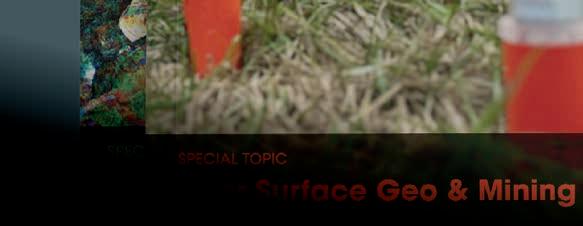












































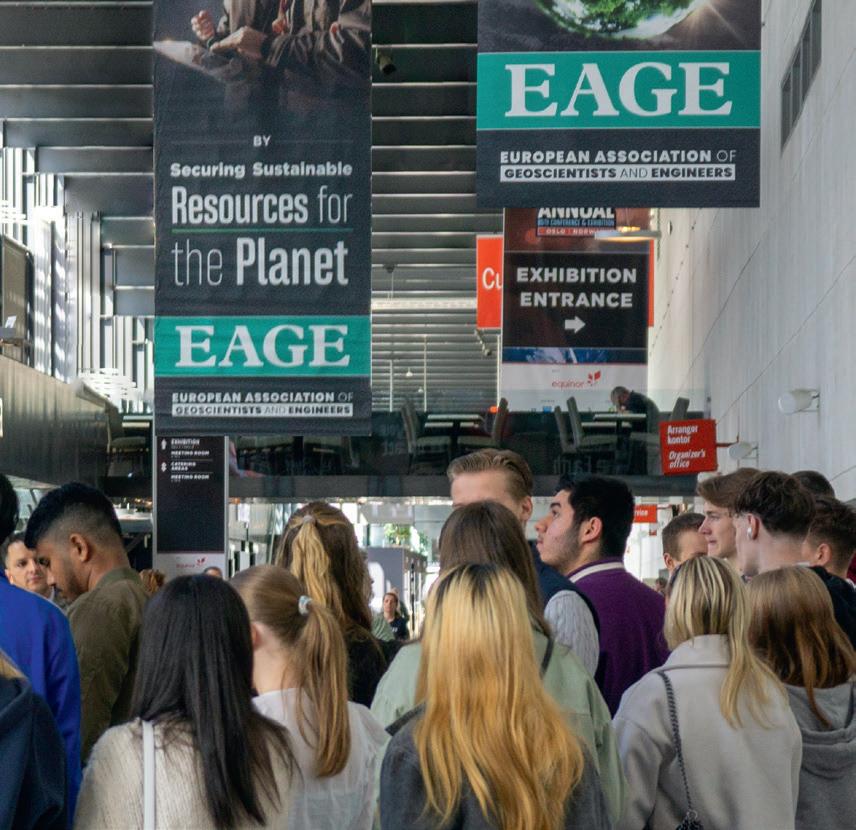


































After the tremendous success of the 2023 edition in Milan, we’re excited to host this prestigious gathering in the Kingdom of Saudi Arabia – the origin of this global event series.
The upcoming 8th Borehole Geophysics Workshop scheduled to take place in Al Khobar, Saudi Arabia from 29 September to 1 October 2025, promises to continue shedding light on the impact of borehole geophysical measurements in the oil and gas industry. For years, these innovative techniques have empowered geoscientists to tackle complex challenges, from pinpointing exact wellto-seismic correlations and fine-tuning velocity models for seismic analysis, to
informing drilling decisions and meticulously monitoring reservoir dynamics.
The workshop takes place against the backdrop of a rapidly shifting energy landscape, driven by the pressing need for sustainable solutions, the importance of precision in reservoir monitoring cannot be overstated. Extending far beyond the confines of traditional hydrocarbon extraction, this pursuit of accuracy also resonates deeply in the growing sectors such as geothermal prospecting, and

pioneering of carbon capture, utilisation, and storage (CCUS) initiatives.
A new era of technological advancement is unfolding, spearheaded by groundbreaking developments in affordable fibre optic solutions – notably Distributed Acoustic Sensing (DAS) and 4C optical point sensors. In tandem, revolutionary leaps forward in surface seismic data gathering via nodal arrays and DAS have enabled synchronised survey captures spanning both subterranean and terrestrial domains. As the symbiosis between surface and subsurface monitoring methodologies deepens, their collective potential for illuminating and overseeing reservoir performance within nascent green energy frameworks continues to captivate professionals worldwide.
For more information
A short course at this year’s upcoming 5th EAGE Digitalization Conference & Exhibition in Edinburgh, Scotland offers an unparalleled insight into the value of data visualisation. On 27 March 2025 Dr Steve Horne (Silixa) will be presenting a foundational short course on Data visualisation principles for scientists.
This one-day classroom course promises to equip participants with essential skills to transform raw data into impactful visuals. Dr Horne, a seasoned research physicist with over three decades of experience in seismic and defence industries, will discuss best practices in scientific visualisation ranging from selection of appropriate chart types to design.
A highlight of the course will be a deep dive into human visual perception. Attendees will learn how to harness biological traits, such as pre-attentive attributes and Gestalt principles, to design intuitive visuals. For example, topics like colour perception and palettes address inclusivity, ensuring visuals are accessible to those with colour vision deficiencies. Dr Horne also tackles common pitfalls, including the misuse of 3D effects, and explains why simplicity often leads to clarity.
The day culminates in a hands-on session where participants will apply the principles covered, redesigning flawed visuals to improve their effectiveness. Whether you work with Excel, MATLAB,

Python, or other tools, this course should help you refine your data visualisation practices to communicate more clearly and effectively.
For more details, visit eagedigital.org.
EAGE’s first Land Seismic Acquisition Workshop, due to take place in Calgary, Alberta, Canada on 8-9 May 2025 is designed to help both operators and vendors meet the challenges of taking today’s technology to the next level in terms of seismic resolution and field efficiency.
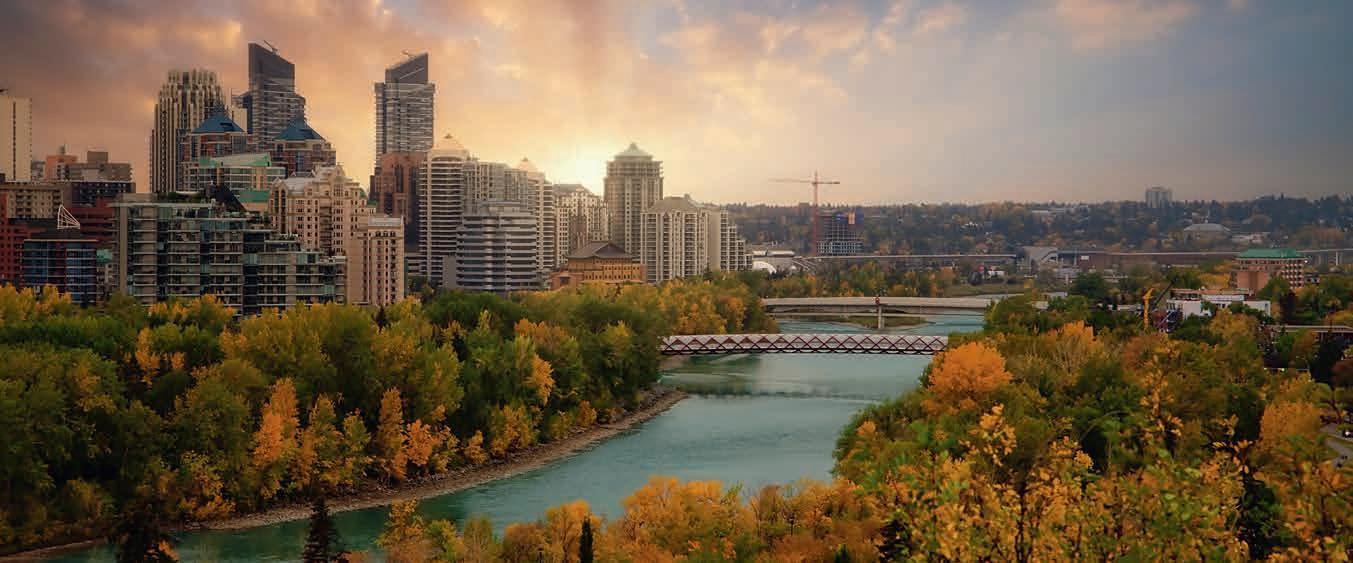
In some areas of the world, high density Vibroseis operations combined with the deployment of nodal equipment systems is commonplace, but in other areas, terrain challenges and equipment limitations abound. Four sessions at the workshop will focus on the latest advances in sampling, sensors, sources, and field implementation so that everyone who attends will hopefully come away with not just a full understanding of the problems facing land seismic acquisition, but also of the solutions that can be immediately implemented on upcoming land seismic acquisition programmes.
Despite our industry’s best efforts, most 3D seismic acquisition geometries still under sample the wavefield. As processing and quantitative analysis methods continue to advance, seismic acquisition
geometries must also be improved to ensure the data acquired will be applicable to the full geophysical lifecycle. The sampling session will explore both conventional and alternative (carpet grid, parallel linear, etc.) seismic acquisition geometries as well as mixed geometry surveys. Case studies will be invited to illuminate how seismic acquisition sampling impacts processing, interpretation, and inversion.
In the sensor space, both advances in analogue geophones and digital sensors will be explored. Case studies examining best practices for transitioning from cabled to nodal systems, including in areas of the world that have limited access to new nodal technologies, will be presented. Methods for addressing ambient noise will be discussed to identify new ways of
accurately and efficiently conducting QC of data while in the field.
Recent advances in new source technologies are enabling surveys in not only more rugged terrains, but also in highly populated areas where traditional sources may be restricted. One session will explore how mixed source surveys can enable innovative solutions for acquiring more effective seismic surveys with lower survey land footprint.
In the implementation session, various case studies will address the challenges of taking a theoretical design into the real world. For example, methods for increasing operational efficiency while maintaining data quality and reducing environmental impact. In all sessions, panels comprising industry experts will discuss the latest technologies and applications.
The EAGE Student Fund supports student activities that help students bridge the gap between university and professional environments. This is only possible with the support from the EAGE community. If you want to support the next generation of geoscientists and engineers, go to donate.eagestudentfund.org or simply scan the QR code. Many thanks for your donation in advance!
We would like to thank our sponsors for their generous support to EAGE in 2024!




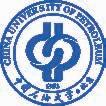
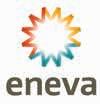







We thank all our valued advertisers for their loyal support in 2024!




We would like to thank our exhibitors for their generous support to
in 2024!
3DHISTECH A Advanced Geosciences Europe S.L. • AeroDelft • Alcatel Submarine Networks. • Allton • Ampseis • Applied Acoustic Engineering Ltd • Aramco • Argeo • ArianeLogix • ARK CLS Ltd • AspenTech • Atlas Fluid Controls • Avalon Sciences Ltd B Baker Hughes • Beicip-Franlab • Bell Geospace • BGP Inc. • Bluware AS • BLUWARE INC. C Canopus Drilling Solutions Geothermal BV • Carbon Guardian LLC • Cegal AS • China Oilfield Services Limited • Chongqing Gold Mechanical & Electrical Equipment Co.,Ltd • Curtin University • CVA Europe Holding D Delft Inversion • Dell Computer S.A. • dGB Earth Sciences • Dhahran Geoscience Society (DGS) • DownUnder GeoSolutions (London)Pty Ltd • Dynamic Graphics Ltd E E&P Consulting Ltd • Earth Science Analytics • Earth Signal Processing Ltd. • EBN BV • Eco-Runner • EIF Geosolutions • EIWT • Eliis SAS • EMerald Geomodelling • EMGS ASA • Engenius Software • Entreprise Nationale de Géophysique, ENAGEO SPA • EOST Strasbourg • EPI Ltd • Eriksfiord • ESRI • ET Works AS • Evotec AS • Excellence Logging F Fibron • Fraunhofer IWES • Fugro GB Marine Ltd. G Gaia Exploración S.L • GEM Systems Advanced Magnometers • Geo Ex Machina • Geoactive Limited • Geocap AS • Geofizyka Torun S.A. • Geological Survey of Finland (GTK) • Geology Without Limits Overseas • Geometrics Inc • Geomind AS • Geopartner Geofizyka sp. z o.o. • Geophysical Insights • GeoSoftware • Geospace Technologies Corp. • Geosurveys - Consultores em Geofisica, Lda • Geoteric • GeoTomo LLC • Geovariances • Geovista Ltd • Gesteinslabor Dr. Eberhard Jahns e.K. • GK Processing • Glex • GRM-services Oy • Guideline Geo H Halliburton Landmark • Hampidjan Advant AS • Hefei Guowei Electronics Company Limited • Heriot-Watt University • HGS Products B.V. I I-GIS A/S • Ikon Science Ltd • Imaged Reality • ImpulseRadar Sweden AB • InApril AS • Indalo International Limited • INOVA Geophysical • INT Inc. • International Seismic Co (iSeis) • IRIS Instruments K Kadme AS • Kalkulo AS • Kappa Offshore Solutions • Katalyst Data Management • King Fahd University of Petroleum and Minerals • Kongsberg Discovery AS • Kongsberg Satellite Services L Leobersdorfer Maschinenfabrik GmbH • Lim Logging • LMK Resources Inc. • Lobster Robotics M Marac Enterprises Inc. • Math2Market GmbH • Medusa Radiometrics BV • MIND Technology, Inc • Moveout Data Services Ltd. N Nimbuc Geoscience • Nissan Chemical Corporation • Norsk Elektro Optikk AS • Nova Scotia Department of Natural Resources and Renewables • NTNU O Omaten • Onward • OPENGOSIM LTD • OvationData Ltd. • Ovun AS • OYO Corporation P PanTerra Geoconsultants BV • Paradigm Geophysical UK Ltd • PE Limited • Petroskills • PetroStrat Limited • PJSC Ukrnafta • Project Geminae • Prores • Prospectiuni SA • PXGEO Services DMCC. Q Qeye • Qeye Labs Canada Ltd. R Radai • RadExPro Seismic Software LLC • Ragnarock Geo • Resman AS • Rezlytix Technologies Pvt. Ltd • Rock Flow Dynamics • RockWave Ltd • ROGII Inc • RoQC Data Management • Roxar Software Solutions AS • RPS Energy S S&P Global Commodity Insights • S3 (cube) Smart Seismic Solutions • SAExploration • Saudi Geophysical Consulting Office • Scanseis Consulting Group AS • Seagate Technology • Searcher Seismic • Seequent • Seisgate • Seismeq AS • Seismic Image Processing Ltd • Seismic Partner • Seismic Source Co • Seismik • Sensys GmbH • Sercel • Sharp Reflections AS • Shearwater Geoservices Limited • Silixa Ltd • Sinopec Geophysical Corporation • Sintef • SkyTEM Surveys ApS • SLB • SmartSolo Inc. • SNF S.A • Solgeo srl • Sonardyne International Ltd • Sound Oceanics LLC • Sound QI Solutions Ltd. • SPH Engineering • Spotlight • STEMA Systems • Stiftelsen NORSAR • Stryde Limited • Subsurface AI inc. • Suzhou Geophysical Deep Sensing Technology Co., Ltd • SYRLINKS T Task Fronterra Geoscience Limited • TDIBrooks International Inc. • Tech Limit • Teledyne Marine • TEMcompany ApS • TERRASYS Geophysics GmbH & Co. KG • TGS ASA • The EasyCopy Company • The Open Group • Tianjin QuikSeis Equipment Co., Ltd • TotalEnergies S.E. • TRE ALTAMIRA • Troika International Ltd U Ulmatec • University of Alberta • University of Stavanger V Verif-i Limited • Viridien • Vr2planets • VRGeoscience Limited • VSProwess Ltd W Weihai Sunfull Geophysical Exploration Equipment • Wintershall DEA AG Z Zhaofeng Sensor Equipment Co Ltd • ZZ Resistivity Imaging Pty. Ltd.
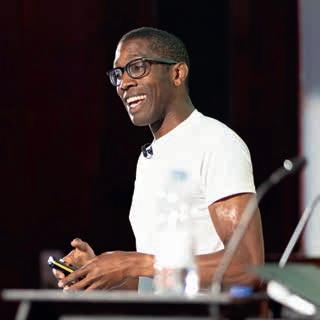
One of few Black geoscientists in the UK, Chris Jackson reflects on a remarkable career to date that includes early geological work in Norway and professorships at Imperial College and University of Manchester before leaving, in part due to perceived institutional racial discrimination in higher education. Now active in energy transition-related work in the private sector, he has emerged as an increasingly wellknown public figure advocating for geoscience and science generally in broadcast media, podcasts and print.
My parents arrived in the UK from Jamaica (Mum) and St Vincent (Dad) in the late1960s, towards the end of the so-called Windrush generation. They met at nursing school in Derby, where I was born. I had a nice childhood, and despite being academically able, I was largely distracted by sports. I played a lot of football and did athletics.
Even as a young person competing in several sports to a fairly high-level, I realised the chances of becoming a professional sports person were very slim. I chose geology by accident, having stumbled across it at an A-Level open day at my local city college. A geology undergraduate degree at university was then an obvious choice, with a subsequent PhD.
My first post-PhD job was for Norsk Hydro (now Equinor) in the research centre in Bergen providing in-house consultancy on a range of structural and stratigraphic projects. The job was fun, and I learned a lot of geoscience, but the best thing was the lifestyle balance. I skied, fished, and visited many exciting places in the mountains.
I left Norway and took an initially part-time academic position in the UK for personal reasons. I never wanted to be an academic, and assumed I’d leave shortly after for another industry job. What little I knew. In my 17 years in academia, teaching was and remains
a huge honour; people are investing their time and money to listen and learn from you.
As Nelson Mandela said, ‘Education is the most powerful weapon which you can use to change the world.’ Swap out ‘education’ for ‘knowledge’, and this effectively outlines my motivation for trying to make access to scientific information more widely and freely available, and for science to be more transparent. In 2017 I co-founded EarthArXiv, the first preprint server for the earth and planetary sciences. Our research group increasingly targets Open Access (OA) journals, or at least those that support professional societies. I also refuse to review for, or submit first-author papers to journals that have OA-hostile policies.
I am technical director (subsurface storage) at the engineering consultancy WSP. I work on a range of geoenergy and geostorage projects. The basic science does not differ between academia and industry, i.e., we collect, describe, and interpret data, with the aim of improving our collective knowledge. However, in my experience, they differ in how success is measured and shared, i.e., individualism in academia vs. a more team-based recognition system in industry. I ultimately left university life for a combination of reasons, including the increasingly hyper-competitive nature of higher education, the desire to apply some of my geoscientific skills to realworld problems, and a specific incident at the University of Manchester. Basically I
wanted to return to a technical rather than administrative position.
Broadcasting career
I fell into (geo)science communication having been asked to give a public lecture at the Geological Society in 2014. Subsequently, the BBC invited me to contribute to BBC2’s Expedition Volcano in 2017. It was all very fortuitous, but having now undertaken science communication via podcasts, radio, TV, and print media, I now realise its value, i.e., we need to clearly communicate how important geoscience is (and who we are) to the public and politicians.
In the UK at least, geoscience is notoriously un-diverse. Yet numerous studies indicate that diversity brings many benefits to organisations. My personal experience has been broadly positive. There have been times, however, when I have been subject to racial discrimination and hostility; this has arisen, at least partly, due to a general lack of diversity in geoscience and related preconceptions of what a geoscientist looks like, i.e., a white man.
I run a lot, having completed 15 marathons, almost 50 half-marathons and last summer, two ultra marathons. Along with cycling, rock climbing, and walking, this keeps me physically and mentally fit. I recently learned to play the guitar, which is very relaxing. Around all this, I enjoy spending time with my family, whether that’s walking in the hills or watching a movie.
Chris Jackson
BY ANDREW

We are entering 2025 with continuing questions if not unease over the progress and direction of the global energy transition agenda. It’s a conclusion based on the generally agreed assumption that only cooperative undertakings between countries everywhere will get us to Net Zero in a desirable timeframe.
This should not come as too much of a surprise, especially for visitors to EAGE’s outstandingly successful GET 2024 Conference and Exhibition in Rotterdam in November. Many presentations at the event demonstrated without a doubt that the geoscience community is enthusiastically embracing research and development of current technical solutions where it can help provide pathways to Net Zero, e.g., wind, geothermal, hydrogen and carbon capture and storage (CCS).
Unfortunately, scientific endeavour can only take us so far. The report card of meaningful take-up of many of these technologies still remains sketchy. Wind turbines are of course the big success story to date with their contribution to total electricity generation worldwide closing in on 10%. Even here in the short term, prospects of continued rapid expansion may be faltering due in some cases to government withdrawal of subsidies, regulatory hurdles and some environmental pushback, all factors affecting the investment model. The US, Sweden and Denmark, countries that have up to now welcomed windpower projects, provide examples of weakening interest, notably the latest offshore wind licensing round in Denmark which did not attract a single bid.
billion tonnes (Gt). This compares with an increase of 490 Mt in 2022 (1.3%).
That said, many countries are increasing efforts to develop new CO2 capturing techniques in order to lower greenhouse gas emissions. According to energy analyst Statista, there were 628 projects in the commercial carbon capture and storage (CCS) facilities pipeline worldwide; 50 of these were operational, while almost 290 were in early development with the majority of upcoming projects confined to North America.
Meantime geothermal has still to deliver power generation at scale, and is currently responsible for less than 1% of global electricity generation. Hydrogen power is even more nascent.
Investment trends tell the renewables story so far. Solar PV and wind power continued to dominate, according to REN21 based on multiple sources. Solar PV accounted for 63% of the 2023 total and wind power for 35%, almost mirroring the 2022 figures. China, the US and the UK together accounted for 66.5% of global wind power investment in 2023. Investment in geothermal energy did expand by nearly 27-fold in 2023 to $8 billion, with more than half of this in the US ($4.3 billion).
‘Scientific endeavour can only take us so far’
CCS was a major focus of GET, understandable as much geoscience technology experience from the oil and gas industry is directly transferable, so feasibility as such is not so much in question. Exemplary European projects such as Northern Lights (Norway) and Porthos (Port of Rotterdam) have to be set against a frustrating reality. Global capture capacity of operational commercial carbon capture and storage (CCS) facilities totalled 51 million metric tons (MT) as of July 2024, a fraction of what is needed given global energy-related CO2 emissions grew by 1.1% in 2023, increasing 410 Mt to reach a new record high of 37.4
Renewable power installations attracted far more investment than fossil fuel power plants in 2023. Investment in new renewable power capacity accounted for 82% of the total global investment in new power generation, including fossil fuels and nuclear but excluding grids and storage. Leaving aside power infrastructure, REN21 estimates that when both upstream and downstream oil, gas and coal and related infrastructure investments are considered, the combined total annual investment in fossil fuels dwarfs that in renewable power and fuels. Investment in upstream oil and gas increased 9% in 2023 to around $538 billion with national oil companies in the Middle East and Asia responsible for nearly all of the increase.
A test of international determination to reduce CO2 emissions will be reached next month (February 2025). This is when parties to the UN Paris Agreement are mandated to submit their climate inten-
tions via Nationally Determined Contributions (NDCs), a statement every five years outlining plans to reduce greenhouse gas emissions to help meet the 2050 Net Zero target. The UN Emissions Gap Report (October 2024) states that emission cuts of 42% are needed by 2030 and 57% by 2035 to get on track. Failure, it says, could result in a temperature increase of 2.6-3.1°C over the course of this century.
G20 nations (Argentina, Australia, Brazil, Canada, China, France, Germany, India, Indonesia, Italy, Japan, Republic of Korea, Mexico, Russia, Saudi Arabia, South Africa, Turkey, UK and US) are charged with needing to do the heavy lifting. Responsible for three quarters of current global emissions, G20 members will largely determine when global emissions reach net zero. All except Mexico and the African Union have at least set net-zero targets. But the Emissions Gap Report records limited progress on key indicators of confidence in net-zero implementation, including legal status, the existence and quality of implementation plans and the alignment of near-term emission trajectories with net-zero targets. A complicating factor for some countries like India is that climate change is actually inviting more fossil fuel consumption to counter extreme heat.
Any international agreement may also be imperilled by some potentially tectonic shifts in the world economic order. Weeks before COP29, the 16th annual international BRICS meeting held in Kazan, Russia, on 22-24 October 2024 was widely regarded as the most meaningful to date. Dismissed by some as a Russian statement of imperviousness to Western sanctions, the membership has grown from Brazil, Russia, India, China, and South Africa to also include Egypt, Ethiopia, Iran, and the United Arab Emirates summit with Saudi Arabia also close to joining. This alignment is sometimes portrayed as a formative Global North and South divide.
‘Up to society and governments to assume command |of this ship’
This bloc would represent over 40% of global oil supply. The presence of major oil exporters alongside key importers such as China and India – neither of which favoured Western sanctions on Russia – highlights the bloc’s potential to establish alternative trade mechanisms that bypass the dominance of the US dollar and the financial influence of the G7, and bring a different perspective to any energy transition initiatives.
Climate change was not at the top of the agenda at the last G20 meeting in Brazil in November., in fact it was something of a bust, convened under the cloud of President Trump’s imminent return to office threatening, among other things, a tariff war, likely opposition to the 2105 Paris climate accord and measures to boost US oil and gas production. There was no condemning of hostilities in Ukraine and Palestine/Lebanon or cautionary statements about rising protectionism worlwide and no explicit commitment to transition away from fossil fuels (despite the landmark roadmap agreement achieved at the Dubai COP28 in 2023).
Such events do not bode well for concerted worldwide action. Last November’s COP29, the foremost international gathering on climate change, didn’t exactly exude united resolve. The optics alone of holding the event in the oil and gas mecca of Baku, Azerbaijan did not bode well. What transpired was an exercise in frustration once again dividing rich and poor nations. The headline trebling to $300 billion of the pledged annual contribution to be made by wealthy nations by 2035 to help poorer nations cope with climate change was greeted as grossly insufficient. The estimated yearly figure needed to reduce emissions and build resilience in vulnerable countries is said to be some $1.3 trillion yearly by 2030. True there were some vaguish agreements on reducing methane emissions and carbon credit trading. However, energy analyst Rystad concluded ‘COP29 has set the stage for transformative change, but the focus must now shift to execution. Whether through targeted financing, aggressive methane reductions, or enhanced NDCs, the race to net-zero emissions requires actionable policies grounded in robust frameworks. The time for ambition has passed – action is now the ultimate test.’
In the blame game, the popular knee-jerk response is to paint the oil and gas industry as the villain in this disappointing climate change narrative. Topped by the US, global oil production is this year expected to reach a new peak of 103 million barrels per day, according to the International Energy Agency. Analysts are divided on future trends. No need to rehearse the energy trilemma to explain why oil companies do what they do. Of course, recent modifications to decarbonisation programmes in companies like bp, Shell and Equinor are not a good look, and it would be nice if energy companies invested more in the alternatives, but that’s not what their stakeholders want.
So, as ever, it is up to society and governments to assume command of this ship. As we can see from global trends that clearly isn’t happening yet. Nor does there appear to be much urgency in public discourse. Campaigner Greta Thunburg, Just Stop Oil, Extinction Rebellion UK, etc. have been relatively quiescent of late despite major floods, heatwaves, wildfires, etc around the world attributed to changes in our climate. One explanation for this may be the so-called issue attention cycle, a concept first articulated by economist Anthony Downs in 1972. The basic premise is that the media cannot sustain public interest for very long in any issue however important before ennui sets in. The exception occurs when the concern directly affects people. In this context climate change is not tangible or upsetting enough in our daily lives.
Public indifference or apathy can only be countered with better understanding of what’s at stake, otherwise the sensationalist claims of madcap climate deniers, doomsters and so forth will be amplified in social media and other public forums potentially drowning legitimate decision-making on CO2 emissions. This is why EAGE is right to advocate a communication policy that promotes the value of geoscience to a wider audience than the bubble of our own professional community. How this can be done is an important discussion.
Views expressed in Crosstalk are solely those of the author, who can be contacted at andrew@andrewmcbarnet.com.





• Train and Launch
• Asset Optimisation
• Operational Excellence
• Seismic Data Integrity
Are you looking to optimize quality control for seismic data accuracy, streamline operations for survey success, or integrate new technologies into your workflow? Whether you are a contractor or an energy company, we are here to help you:
• Operation Supervisor Support
• Continuous Update & Upskill
Book a meeting now!

Book a meeting with our specialist and get expert technical guidance and strategies to improve operational performance.

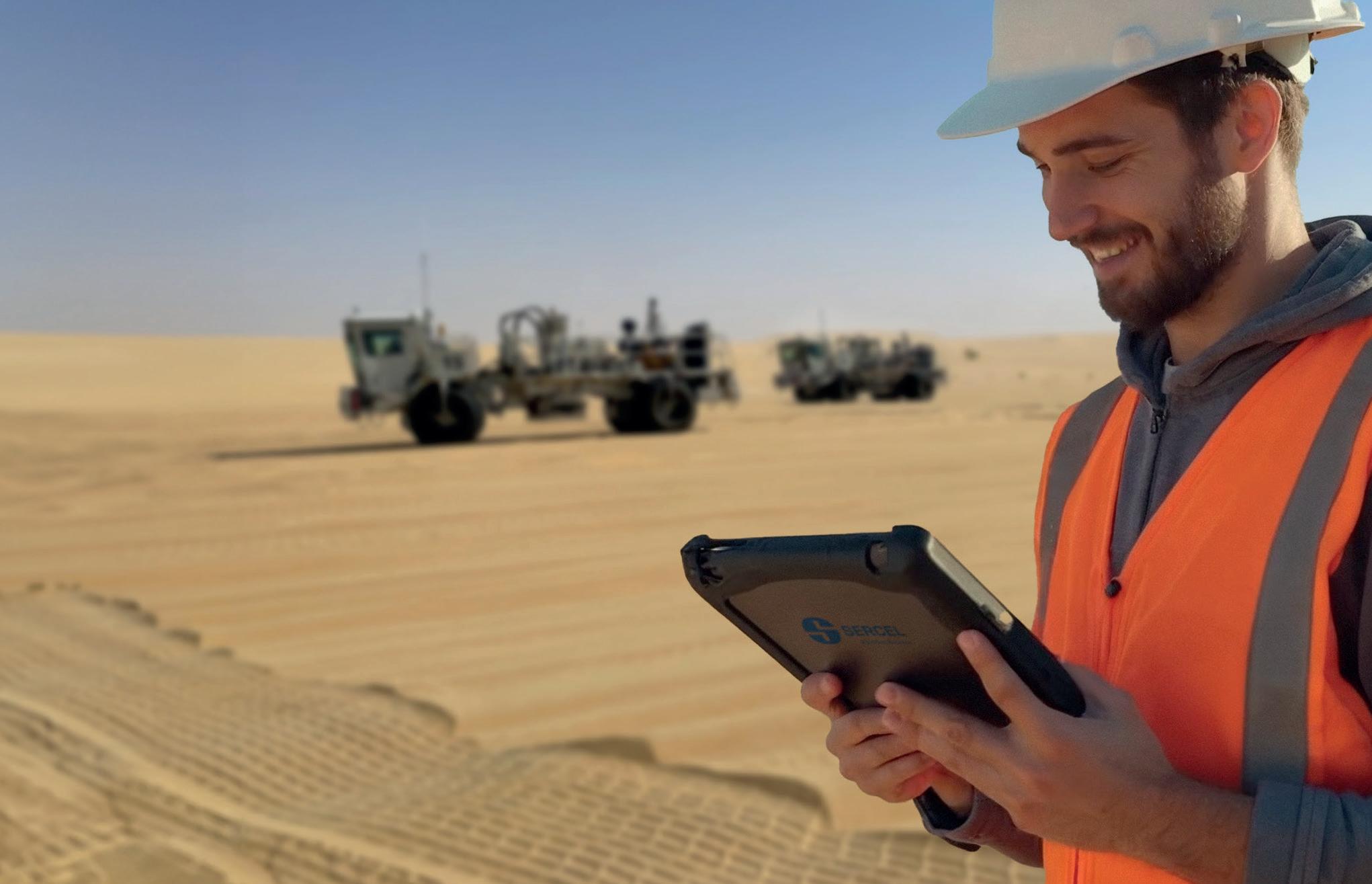
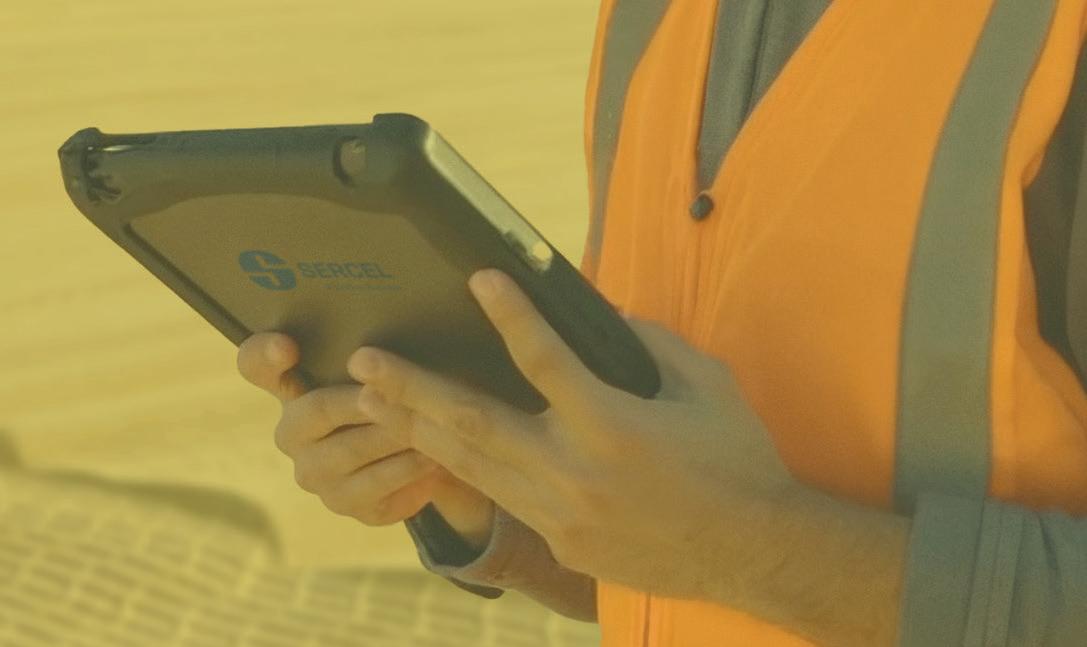
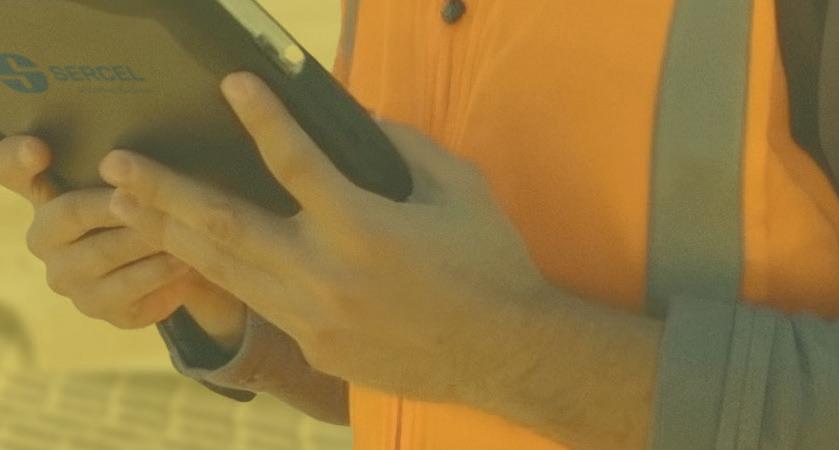


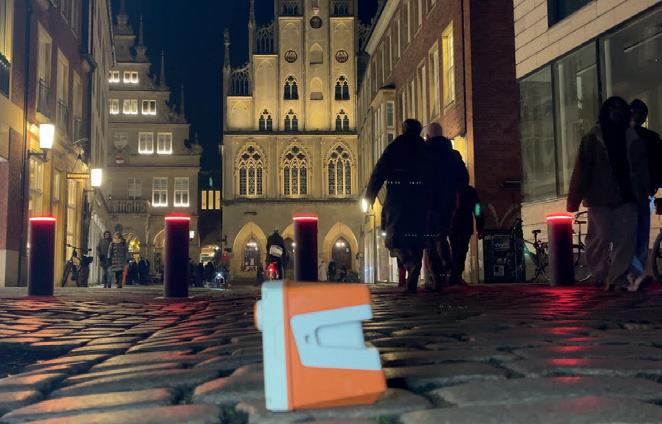
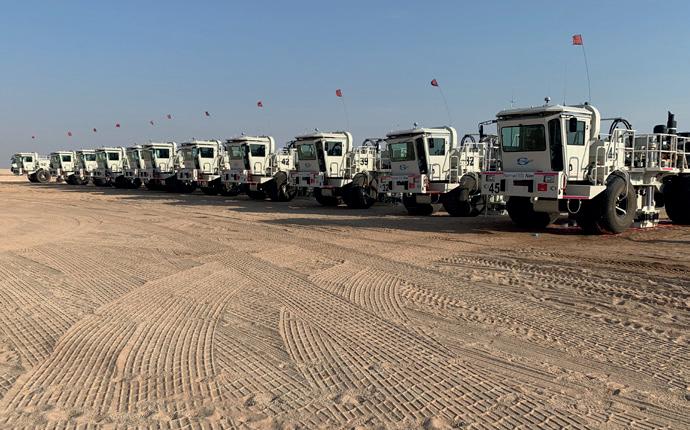

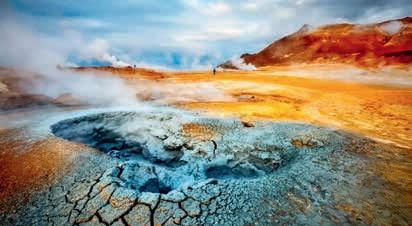
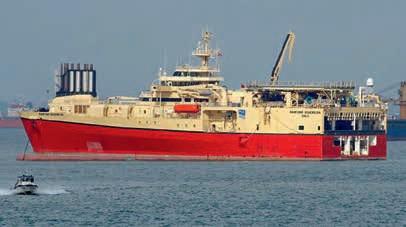
Equinor and Shell are combining their UK offshore oil and gas assets to form a new company which will be the UK North Sea’s biggest independent producer and ‘sustain domestic oil and gas production and security of energy supply in the UK’.
The incorporated joint venture will be equally owned by Equinor (50%) and Shell (50%), even though Equinor currently produces around 38,000 barrels of oil equivalent per day in the UK and Shell UK 100,000 barrels.
‘With the once prolific basin now maturing and production naturally declining, the combination of portfolios and expertise will allow continued economic recovery of this vital UK resource. The new company will be more agile, focused, cost-competitive and strategically well positioned to maximise the value of its combined portfolios on the UK Continental Shelf,’ said the companies in a joint statement.
Shell and Equinor claimed that the joint venture is good news for companies active in the British oil and gas industry, including seismic contractors and consultants, that were fearing a downturn of work in UK waters. ‘The new company will invest to provide a long-term sustainable future for individual oil and gas fields and platforms, helping extend the life of this crucial sector,’ the statement continued.
Based in Aberdeen, the joint venture will include Equinor’s equity interests
in Mariner, Rosebank and Buzzard, and Shell’s equity interests in Shearwater, Penguins, Gannet, Nelson, Pierce, Jackdaw, Victory, Clair and Schiehallion. A range of exploration licences will also be part of the transaction.
Equinor will retain ownership of its cross-border assets, Utgard, Barnacle, and Statfjord, and offshore wind portfolio including Sheringham Shoal, Dudgeon, Hywind Scotland, and Dogger Bank, according to the statements, which highlighted that it will also retain the hydrogen, carbon capture and storage, power generation, battery storage, and gas storage assets.
Shell UK will retain ownership of its interests in the Fife NGL plant, St Fergus Gas Terminal, and floating wind projects under development – MarramWind and CampionWind. The company will also remain technical developer of the Acorn carbon capture and storage project.
Equinor’s executive vice-president for exploration and production international, Philippe Mathieu, said: ‘Equinor has been a reliable energy partner to the UK for over 40 years. This transaction strengthens Equinor’s near-term cash flow, and by combining Equinor’s and Shell’s long-standing expertise and competitive assets, this new entity will play a crucial role in securing the UK’s energy supply.’
Shell’s Integrated gas and upstream director, Zoë Yujnovich, said: ‘Domes-
tically produced oil and gas is expected to have a significant role to play in the future of the UK’s energy system. To achieve this in a mature basin, we are combining forces with Equinor, a partner of many years. The new venture will help to play a critical role in a balanced energy transition.’
Equinor employs around 300 people in oil and gas roles in the UK, while Shell employs approximately 1000. ‘We don’t anticipate any staff reductions as a direct result of this announcement,’ a Shell spokesperson said. ’However, there are a number of reorganisations which have already been announced. We expect only limited additional job reductions ahead of this transaction.’
Equinor said that it ‘is not planning any down-manning as part of this transaction’.
Wood Mackenzie said the deal would create a UK energy ‘superpower’ that would deliver 220,000 barrels of oil equivalent a day by 2030, well ahead Harbour Energy, which delivers 130,000 barrels of oil equivalent per day.
‘The venture will create the biggest producer on the UK Continental Shelf and demonstrates the long-term attractiveness of the region,’ said Gail Anderson, a research director at Wood Mackenzie. ‘There is also potential for future fields, as both companies acquired acreage West of Shetland in the 33rd licensing round.’
The transaction was due to come into effect on 1 January 2025.
Chevron has announced an organic capex budget of $14.5-15.5 billion and affiliate capex budget of $1.7-2 billion for 2025. Restructuring and other charges are expected to be $1.1 to $1.5 billion. The company’s 2025 budgets represent a $2 billion year-over-year reduction. ‘The 2025 capital budget along with our announced structural cost reductions demonstrate our commitment to cost and capital discipline,’ said Chevron Chairman and CEO Mike Wirth.
Eni and the Ministry of Mines, Oil and Energy of Côte d’Ivoire have signed contracts for the acquisition of four offshore exploration blocks. Blocks CI-504, CI-526, CI-706 and CI-708 cover 5720 km2 with a water depth ranging between 1000 and 3500 m; their proximity to the Calao discovery, made in Block CI-205, represents a strategic opportunity to create further synergies in the area, said Eni.
EMGS has signed a $10 million contract with an undisclosed client for a CSEM survey in India. The vessel Atlantic Guardian is expected to commence transit from Norway in the fourth quarter of 2024.
ExxonMobil has notified Staatsolie that it will withdraw from Block 52 in the Surinamese offshore area on 14 November 2024. This withdrawal is part of ExxonMobil’s ongoing evaluation of assets in its global portfolio. ExxonMobil is transferring its 50% working interest to Petronas, which is the operator of the block.
SeaBird has reported third quarter revenues of $10 million with EBITDA of $4.4 million. Net interest-bearing debt is $10.7 million; utilisation of its fleet was 98%.
Petronas has won production sharing contracts (PSC) for three discovered resource opportunities clusters and one exploration block offered under the Malaysia Bid Round (MBR) 2024, which was launched earlier this year. The PSCs cover nine fields and one exploration block, featuring oil and gas discoveries located offshore Peninsular Malaysia and off the coast of Sabah.
Shearwater Geoservices has won a contract for a 15,500 line-km 2D seismic survey on the continental shelf margin off the west coast of India.
The vessel SW Thuridur will acquire the data for approximately five months, starting in Q4 2024. The project, part of India’s National Seismic Program (NSP), will play an important role advancing India’s strategic approach to map key unappraised offshore areas, said Shearwater.
Irene Waage Basili, CEO of Shearwater, said: ‘The data acquired will not only advance understanding of unappraised areas but will also lay the groundwork for future 3D seismic acquisition programs.’
Meanwhile, the company has won a 14,500 line km 2D towed-streamer seismic survey by Oil India Ltd, on the east coast of India in the Bay of Bengal. The project, scheduled to commence early 2025, forms part of India’s National Seismic Program (NSP) and is expected to last around five months.
‘This contract marks the second NSP survey, and third towed streamer project awarded to Shearwater for this season in India, emphasising our strong position in the Asia Pacific region,’ added Basili.
Meanwhile, Shearwater has won a contract from ONGC for a large 3D seismic survey off the east coast of India. The vessel Oceanic Sirius will carry out the survey, covering an area of approx. 2200 km2, which is expected to take approx. four months, commencing early 2025.
Basili said: ‘Our expertise in 3D seismic acquisition, combined with our track-record of eight consecutive seasons of India operations, ensures that we are well positioned to deliver data in line with our clients exploration needs.’
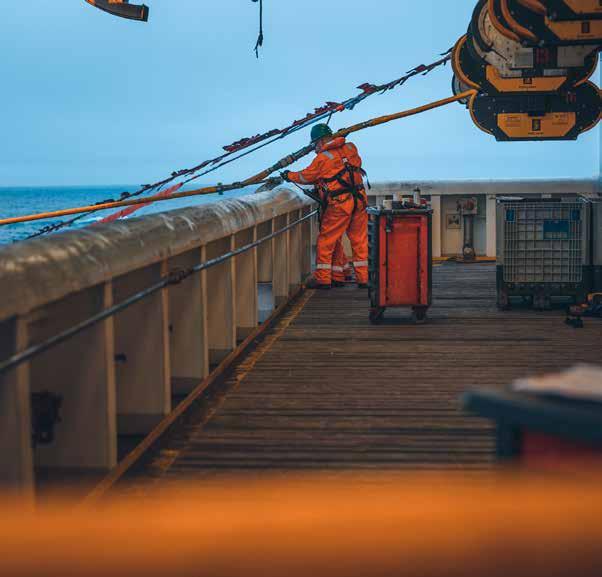
DUG Technology (DUG) has signed a partnership with PetroVision aimed at promoting and delivering specialised seismic data processing solutions in Nigeria.
PetroVision will facilitate operations within Nigeria, while DUG will supply technology and support. This includes use of the DUG Insight processing, imaging and interpretation software and remote access to DUG’s teams of geophysical experts. PetroVision will manage a local processing office within Nigeria, utilising computer resources via the DUG HPC Cloud platform.
DUG provides geoscience services, analytical software and reliable cloud-
based high-performance computing (HPC).
PetroVision is an integrated energy consultancy which advises on geoscience, engineering and economic aspects in the upstream, midstream and downstream sectors while also working on carbon capture and storage projects and providing field exploration geochemical sampling for critical minerals, such as lithium.
DUG’s managing director Dr Matthew Lamont said: ‘We are looking forward to working closely with the team at PetroVision to build a strong presence, and grow our client base in Nigeria.’
TGS and joint venture partner Viridien have completed the multi-client Heimdal Terrace Ocean Bottom Node (OBN) project in the North Sea and delivered the final processed data.
The Heimdal Terrace OBN survey, the first of two multi-client dense OBN surveys acquired in the North Sea in 2023, spans 426 km2 in a mature region that includes the Balder and Ringhorne fields as well as nearfield exploration acreage. Conducted from April to June 2023, the survey employed up to three node-handling vessels, two triple-source vessels and four support vessels. The data acquisition resulted in 28,814 node positions and nearly 1.2 million shot points, providing an extensive new dataset for the region.
Processing and imaging techniques included deblending, noise attenuation,
up-down deconvolution, and pre-stack depth migration. A velocity model was generated using least-squares diving-wave full-waveform inversion (FWI) followed by time-lag FWI, utilising the full recorded wavefield, including refractions, reflections, diving waves, ghosts, and multiples, to capture subsurface detail at all depths.
‘The imaged data shows substantial improvement in resolution and structural clarity over previous datasets, offering crucial insights into the region’s complex geology and reservoirs. This enhanced imaging, including depth-time conversion, will be valuable to explorers operating in the area for years to come,’ said the companies in a joint statement.
Meanwhile, TGS has won an OBN contract in Europe from a repeat customer
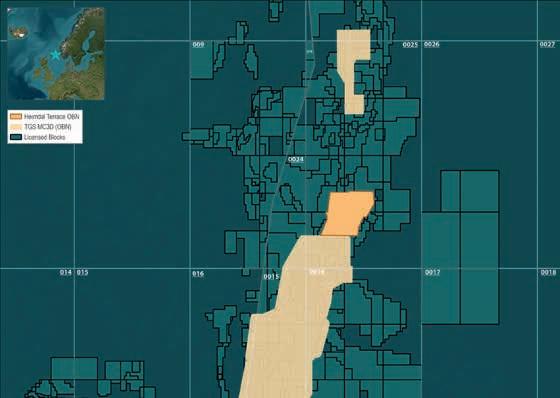
to ‘optimise resource extraction over a well-established’ producing field. The company’s node-on-a-rope crew is scheduled to commence acquisition in early April 2025 and the contract has a duration of approx. 35 days.
Seequent has signed a two-year partnership with the International Geothermal Association (IGA) to boost geothermal energy’s role as a sustainable and reliable renewable energy source.
Seequent software supports more than half of the world’s geothermal electricity production, bringing clarity to a complex unseen challenge of managing subsurface resources. The company has been involved in projects to bring geothermal energy directly to heat homes in Paris and Munich.
Its innovations include adding new physics capabilities to its software to trace fluids more accurately, ultimately leading to more efficient resource management and a more sustainable geothermal operation.
Marit Brommer, chief executive officer, IGA, said: ‘Geothermal energy has been overlooked as a reliable and sustainable energy source. Partnerships like this are essential to accelerating its growth. We are excited to partner with Seequent, whose technological innovations in subsurface modelling bring clarity to geothermal development, empowering
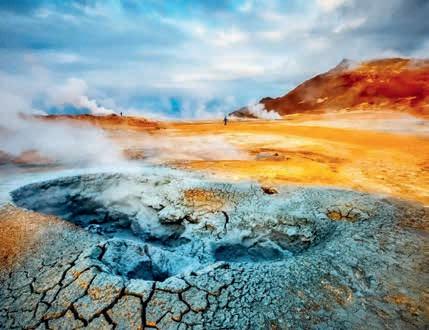
countries to leverage this clean energy resource and drive meaningful progress toward global net zero goals.’
Graham Grant, chief executive of Seequent, said: ‘An emerging use case for geothermal is the rise of hyperscale AI-enabled data centres which represent a rapidly emerging new form of power demand requiring reliable baseload, or consistent, power supply. Geothermal is the cleanest form of renewable energy, able to provide this baseload power and should play a key role in future data centre strategy globally.’
Seequent customer Fervo Energy is applying oil and gas technology to find new ways to produce geothermal energy
for Google’s data centres in the Nevada desert.
Jack Norbeck, chief technology officer and co-founder, Fervo Energy, said: ‘Seequent’s partnership with the International Geothermal Association marks an important step in advancing the role of geothermal in the global energy transition. At Fervo, we’ve experienced firsthand how Seequent’s technologies enhance our ability to manage and optimise geothermal reservoirs.’
The latest UN Emissions Report found geothermal energy had the potential to mitigate more energy emissions by 2035 than carbon capture and storage, or bioenergy, or the reduction of methane emissions from coal mining.
The International Renewable Energy Agency (IRENA) has said geothermal energy production in Europe could grow eight-fold by 2050, and the US Department of Energy predicts that similar advancements could drive a 26-fold increase.
The US Department of Interior has recently begun unlocking permitting constraints on public lands, said Seequent.
Viridien has announced the ‘sudden and untimely’ death of David Le Meur, research principal at its Massy Subsurface Imaging Centre in France.
Le Meur, who was 56, joined what was then CGG in 1997 after earning a PhD from Université Paris XI (now Université Paris-Saclay). His career in the company’s imaging research team included a three-year posting to its Calgary processing centre from 2004 to 2006 followed by a one-year assignment at its Muscat dedicated processing centre.
After being promoted to manager of the land processing research team in 2013, he and his team made significant technical advances in areas such as surface-con-
sistent processing, interferometry, random and erratic noise attenuation, surface- and multi-wave inversion, and, more recently, land demultiple.
Over the years, Le Meur became Viridien’s research expert on land processing, particularly the imag ing challenges of the Middle East and North Africa. In recent times, he was research principal for Viridien’s Massy Subsur face Imaging Centre in France, where he managed its land and marine processing R&D team.

‘David’s expertise, dedication and commitment to innovation meant that he was highly respected within the company and the wider technical community,’ said Viridien in a statement. ‘Playing an active role in the EAGE and SEG and communities, he was often an invited or keynote speaker and regularly participated in the leading technical workshops. Our heartfelt thoughts are with his wife and three children.’
David Le Meur died on 13 November 2024.

TGS has won a ‘significant 3D streamer contract from ONGC in the Mahanadi basin on the east coast of India. The vessel Ramform Sovereign is scheduled to mobilise for the survey
in January 2025 and the contract has a duration of approximately six months.
‘India is a hotspot for streamer seismic and ocean bottom node work and the contract award strengthens TGS’ position in the area, underscoring the company’s ongoing commitment to providing the highest quality data solutions to clients,’ said TGS in a statement.
Meanwhile, TGS has won a large 3D streamer contract in the South Atlantic. Acquisition is scheduled to commence in Q4 this year and the contract has a duration of approximately 140 days.
Kristian Johansen, CEO of TGS, said: ‘The comprehensive seismic survey is designed for enhanced subsurface imaging in a challenging geological environment. Our Ramform acquisition platform, coupled with our proprietary GeoStreamer and Gemini source technology will secure delivery of high-quality seismic 3D data.’
The UK North Sea Transition Authority (NSTA) is inviting bids to carry out two subsurface modelling projects to improve understanding of the relationships between pressure and formation fluid movement in saline aquifers that could store carbon dioxide.
For Tender 1, the NSTA is seeking proposals to help understand the impact that the movement of subsurface fluids – due to pressure changes induced by CO2 injection – may have at existing well locations.
Tender 2 is to run simulations using representative fluid properties of CO2
to investigate the subsurface factors that most influence or control the behaviour of migrating CO2.
Bidders have until 29 November 2024 to submit their applications. The project must be completed on or before 31 March 2025.
BP and JERA are combining their offshore wind businesses to form one of the largest global offshore wind developers, owners and operators.
JERA Nex bp will have a mix of operating assets and development projects with total 13GW potential net generating capacity. Combining their pipeline and bolstering access to competitive financing, the partners have agreed to invest $5.8 billion before end of 2030.
The combined companies have operating assets with around 1GW net generating capacity, a pipeline comprising around 7.5GW capacity, and further secured leases with around 4.5GW of potential capacity.
JERA Nex bp will initially focus on progressing existing projects in NorthWest Europe, Australia and Japan, and ‘mature the development pipeline of significant longer-term opportunities’.
JERA entered the offshore wind market in 2019 through investments in projects in the UK and Taiwan. In 2023 it acquired Belgium offshore wind player,
Parkwind, and used this business to form a renewables vehicle, JERA Nex. It owns and operates wind farms in Belgium, Germany, Japan and Taiwan and has a development portfolio that includes projects in Japan, Ireland, and Australia.
bp has been building a portfolio in offshore wind since 2019, and now has a development pipeline of 9.7GW net (5.7GW development projects and a further 4GW secured leases). Development projects are the Morgan and Mona schemes in the UK Irish Sea, and Oceanbeat East and Oceanbeat West in Germany’s North Sea, with secured leases off Scotland and the east coast of the US.
JERA Nex bp will be based in London. Its CEO will be nominated by JERA and the CFO by bp. On completion, offshore wind teams from both JERA and JERA Nex and staff from bp’s offshore wind business will be expected to move into the new business.
The deal is expected to be completed in Q3 2025.
Shearwater GeoServices has reported third quarter revenues of $178.7 million compared to $267.3 million in Q3 2023. Operating profit of $13.6 million compared to $52.7 million in Q3 in 2023.
Vessel utilisation of 61% (11.1 active vessels), compared to 75% in Q2 2023 (13.6 active vessels).
Irene Waage Basili, CEO of Shearwater, said high activity at the start of the quarter was followed by increased idle-time due to completion of several projects. However, the company won several contracts in Q4 2024 and backlog is $360 million.
‘The marine seismic acquisition market has been slower than expected in 2024. We saw seasonal increase in demand over the North Sea summer albeit not as prolonged as we saw last year.
Although activity levels in the fourth quarter will be low, the project pipeline
for the upcoming winter season and further into 2025 is encouraging, indicating increased demand in our core markets around the world. We have seen a recent increase in contract awards, but as expected, we also see projects move into 2025 that were previously assumed for fourth quarter execution.’
Basili called current ‘market rates’ for seismic acquisition ‘challenging’. ‘it is important that the industry maintains rates that are sustainable and reflect the value creation enabled by state-of-the art technology and high-quality subsurface data.
‘Our commitment to advancing seismic technology and our role as industry consolidator over the cycle, position us to capitalise from increased demand. As the timing of that demand remains uncertain, Shearwater is currently evaluating the optimal size of the swing capacity.’


Full-Wave Correc/on (FWCTM) Technology can address sca9ering and improve your challenging seismic data
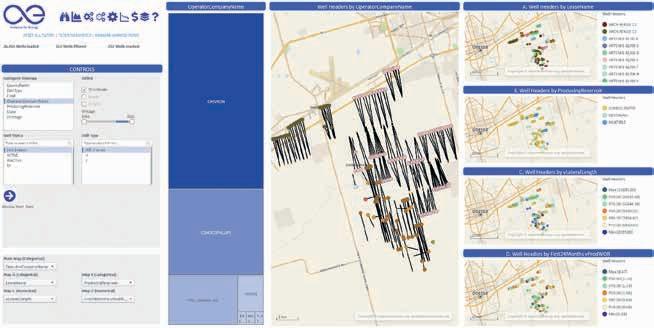
A4E Well Spacing automates spacing measurements, offering an easy-to-use interface in Spotfire. It calculates well density using user-defined ellipses, analyses parent-child relationships and degradation over time, and provides traditional X, Y, Z spacing measurements.
TGS has announced a strategic partnership with Blue River Analytics, creators of the Analytics for Energy (A4E) Suite on the Spotfire platform. The collaboration integrates TGS’ production, completions and cost data directly into the A4E Suite, providing E&P companies with ‘a more efficient and effective approach’ to forecasting and analysing production and well data. By combining TGS’ data with Blue River Analytics’ platform, customers can now create forecasts and valuations in minutes, enabling data driven decision-making at every stage of exploration and production, said TGS.
‘As the energy sector relies on timely, reliable data for informed decisions, this integration eliminates the need for
manual data preparation and transformation,’ said TGS. ‘Users can now work with TGS datasets seamlessly within Spotfire, leveraging Blue River Analytics’ advanced valuation and forecast workflow. With capabilities like advanced decline curve analysis, type well profiles, probabilistic Markov Chain Monte Carlo (MCMC) forecasting, workover detection and reserves import/ export, all in one interface, operators can make decisions faster and with greater precision.’
The A4E Well Spacing tool automates spacing measurements, offering an easy-to-use interface in Spotfire. It calculates well density using user-defined ellipses, analyses parent-child relationships and degradation over time, and provides traditional X, Y, Z spacing measurements.
David Hajovsky, executive vice-president of multi-client at TGS, said: ‘This partnership diversifies the ways our customers can access and leverage our comprehensive data library. It saves operators weeks of time while improving the accuracy of their economic models and updates.’
John Buckley, founder and CEO of Blue River Analytics, said: ‘In today’s competitive energy market, quick and easy access to high-quality data is crucial for confident, data-driven decisions. Our partnership with TGS removes traditional barriers to data, supporting E&P companies, mineral companies, banks and private equity firms with optimised workflows that produce highly accurate forecasts in minutes.’
Viridien has signed an agreement with MS4ALL, a French start-up focused on molecular simulation. The collaboration further expands Viridien’s HPC & Cloud Solutions business by combining its expertise in sustainable HPC, artificial intelligence (AI) and cloud technologies with MS4ALL’s molecular simulation capabilities.
The agreement will accelerate the development of the new and innovative materials needed for many industrial sectors and evaluate more effective ways to reduce the environmental impact of micropollutants, both of which require computational-intensive simulation. MS4ALL will leverage Viridien’s fully managed HPC, AI and Cloud services to screen and identify the right elementary constituents of new target materials and simulate the degradation of micropollutants in their environment.
Through this agreement, MS4ALL will benefit from the support of Viridien’s dedicated technical teams and customised, optimised solutions, resulting in accelerated simulations, productivity-driven operations, and lower costs.
Additionally, Viridien’s Outcome-asa-Service model, which delivers AI and HPC Cloud with pricing based on results rather than consumption, aligns with MS4ALL’s own customer billing model, ensuring a seamless and efficient collaboration.
Agnes Boudot, EVP, HPC & Cloud Solutions, Viridien, said: ‘We are supporting MS4ALL’s mission to develop new materials and address the environmental challenge of micropollutants.’
Edouard Lété, CEO of MS4ALL, said: ‘By leveraging Viridien’s advanced HPC, AI, and Cloud services, we can accelerate our research and development
processes, ultimately bringing innovative materials to market faster and globally addressing the major issue of micropollutants.’
Meanwhile, Viridien has launched its industrial Viridien Cloud for AI and HPC production in the US, offering tailored cloud solutions and end-to-end expertise to optimise compute-intensive production workloads.
The company is introducing its cloud solutions to meet the evolving needs of sectors, including AI, life sciences, engineering, digital media and energy. The US launch of Viridien Cloud offers access to Viridien’s Outcome-as-a-Service (OaaS) model — a results-driven approach where pricing is based on outcomes, rather than consumption. OaaS provides end-to-end performance optimisation aligned with business KPIs, ensuring predictable, guaranteed costs.
Monitor Exploration and joint venture partner has completed initial processing and interpretation of the 2D seismic acquisition at PEL 93, an 18,500 km2 licence in the Owambo Basin, onshore Namibia.
Interpretation has identified an initial suite of 10 significant independent structural closures within the licence area.
‘Monitor’s initial interpretation of the 2024 2D seismic data confirms the presence of multiple significant leads in the southern area of PEL 93, each with large interpreted structural closures, with some individual leads covering up to approximately 100km2, exhibiting prominent vertical relief and clear hydrocarbon charge potential from source rocks beneath the prospects and in the kitchen to the north,’ said the joint venture partners in a statement.
to evaluate the potential of the licence since the award of PEL 93 in 2018. Ten independent structural closures were initially identified using airborne geophysical methods and later refined with newly interpreted 2D seismic data.
Further analysis of ethane (C2H6 or ‘C2’) concentrations in soil samples over these structures suggests the presence of an active petroleum system. Passive seismic anomalies also align closely with structural leads and measured alkane (C1-C5) concentrations in soil.
These results will contribute to a final prospective resource estimate, completion in the first half of 2025. The JV may conduct further geophysical activities including, acquisition of additional 2D seismic data before the next phase of the PEL93 work-programme, which
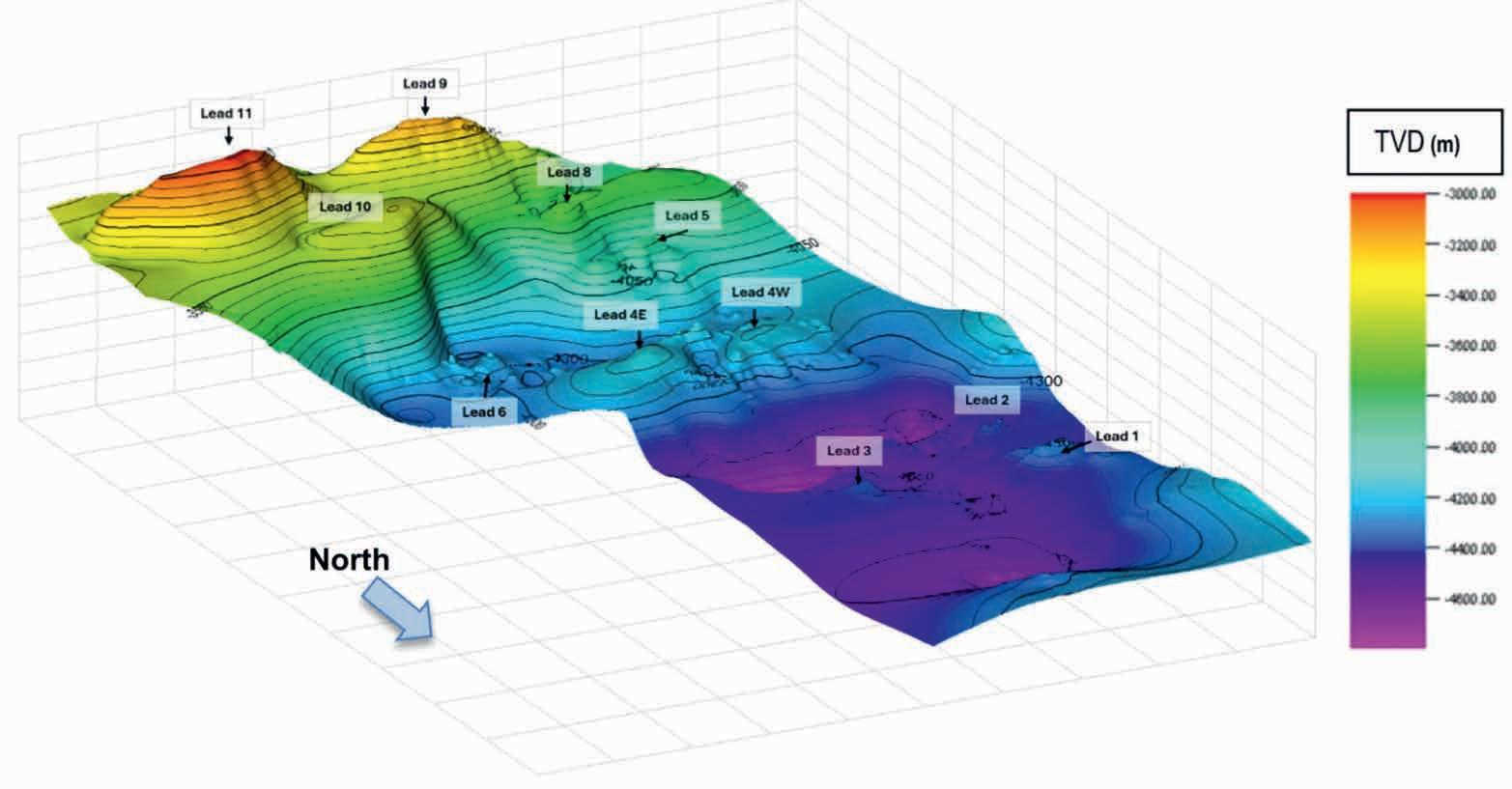
Joint venture partner 88 Energy is validating Monitor's findings and work with the will integrate all available well log data, airborne geophysics, soil geochemistry together with the 2D seismic dataset.
A prospective resource estimate for PEL 93 is targeted for completion in 1H 2025, following the internal review of Monitor's seismic interpretation.
Monitor has employed various geophysical and geochemical techniques
includes a single well commitment. Additional 2D seismic may be acquired over lead 11 which has recently emerged as a result of additional mapping by Monitor, based on existing gravity and geochemical data.
Monitor Exploration is operator of Petroleum Exploration Licence 93, with a 55% interest while 88 Energy, holds 20%. Legend Oil (15%) and the National Petroleum Corporation of Namibia (Namcor) 10%.

Aramco has signed a shareholders’ agreement with Linde and SLB, paving the way for development of a carbon capture and storage (CCS) hub that is expected to become one of the largest globally. Under the terms of the shareholders’ agreement Aramco will take a 60% equity interest in the CCS hub, with Linde and SLB each owning a 20% stake. Phase one of the new CCS hub in Jubail is expected to capture and store up to nine million metric tons of CO2 annually, and construction is expected to be completed by the end of 2027.
A consortium comprising TotalEnergies and Saudi developer Aljomaih Energy and water company (AEW) has signed a 25-year power purchase agreement with the Saudi Power Procurement Company (SPPC) related to the 300 MW solar power project, Rabigh 2. This project is part of Saudi Arabia’s Round 5 of the National Renewable Energy Program. The solar plant will be developed, built, owned and operated by the consortium with a connection to the grid planned in 2026.
DNV has certified the feasibility of ADNOC’s West Aquifer CO2 storage site in the UAE. The certificate of feasibility covers the initial subsurface assessments of the Simsima and UER saline reservoirs. The project, guided by DNV-SE-0473, is based on the ISO 27914 standard.
Block Energy has started phase 2 studies for the company’s carbon capture and storage project in licence XIB in Georgia. The studies will be undertaken in partnership with Rustavi Azot. Technical support will be provided by Oilfield Production Consultants, which originally defined the potential of the licence for carbon sequestration. Phase 2 will include desktop and laboratory studies followed by a pilot injection scheme designed to achieve a monitoring and verification plan for carbon storage. Three commercialisation options have already been identified.
BP, Equinor, Shell and TotalEnergies have announced a commitment to invest $500 million in support of the UN Sustainable Development Goal 7 (UN SDG7), which aims to ensure access to affordable, reliable, sustainable, and modern energy for all.
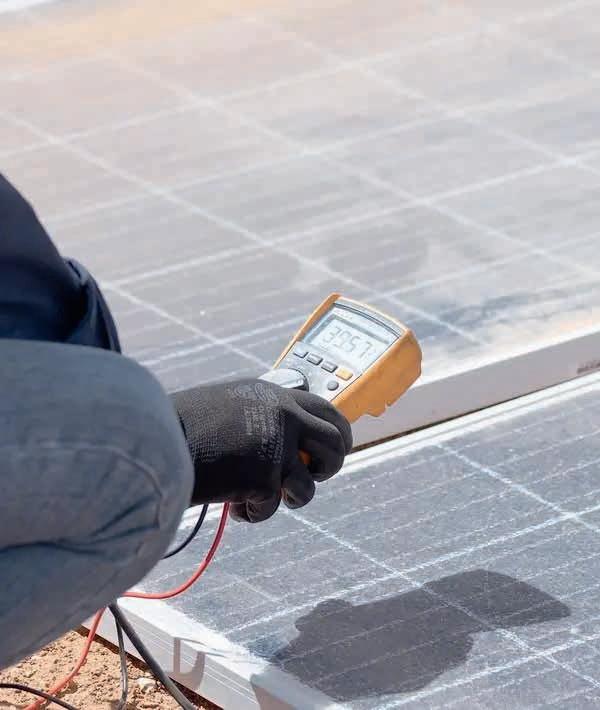
Progress towards universal energy access has stalled, particularly amid recent macroeconomic shocks and rising energy prices, the companies said in a statement. In 2022, the number of people without access to electricity globally increased by around 10 million to 685 million. Additionally, approximately 2.1 billion
people, primarily in sub-Saharan Africa and Southeast Asia, lack access to clean cooking facilities.
The fund will support projects primarily in Sub-Saharan Africa, South and Southeast Asia, aiming to help millions of people in underserved communities gain access to electricity and improved cooking conditions. Capital will be invested in solutions, including solar home systems, mini/metro grids, clean cooking solutions, and enabling technologies (such as e-mobility, energy storage and management solutions).
A global private equity firm ‘with a strong track record in impact investing’, has been selected to manage the joint investment and support the investments being strategically directed to create both social impact and financial returns, while engaging with governments, international organisations, financial institutions, the private sector, civil society, and philanthropies.
Murray Auchincloss, CEO of bp, said: ‘We hope we will be able to contribute to wider efforts to tackle the very real challenge of access to energy. Over time, we believe it can help to create a more inclusive energy future for some of the many millions of people who lack that access today.’
Viridien has completed the seismic imaging for the Selat Melaka multi-client 2D seismic program, covering the offshore area of the Langkasuka Basin, Malaysia. The available final seismic dataset clearly indicates the presence of a previously unseen Pre-Tertiary fold and thrust belt, extending offshore across the unexplored area, Viridien said.
‘The new high-resolution long-offset dataset provides extensive seismic coverage and significantly enhanced imaging over this promising area,’ said the company in a statement. Viridien’s subsurface imaging experts have applied the company’s latest high-end imaging
technologies, including full-waveform inversion and Q-tomography, for the first time in the Langkasuka Basin.
Dechun Lin, EVP, Earth Data, Viridien, said: ‘We are delighted to have completed our first multi-client project offshore Malaysia, that leverages over 40 years of experience processing seismic data from one of the country’s major basins. We are confident that this ultramodern data set will support the efforts of Petronas in promoting open acreages in Selat Melaka and spur exploration in this frontier area located near a number of proven large discoveries.’

OptiSeis provides innovative, high-resolution seismic acquisition software and services for all types of subsurface exploration and production projects including energy, critical minerals, carbon sequestration, geothermal, wind, and nuclear. With lower environmental footprint and reduced GHG emissions as well as safe and efficient operations, OptiSeis is your collaborative solutions provider of choice.
























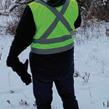














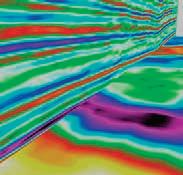

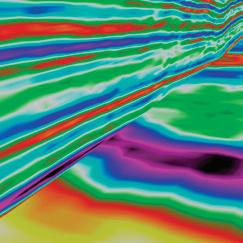


















Land seismic solutions are improving to facilitate ever more channels, more hardwearing and smaller nodes along with more cableless systems to ensure effective acquisition in all terrains, in challenging weather and with little downtime.
Andrew Clark et al discuss various deployment methods using modern nodes in TZ environment with examples from recent successful 3D surveys.
Tim Dean et al demonstrate that high-resolution mini-3D seismic surveys can be used as an alternative to drilling to quickly and can easily identify structural issues in high-priority areas and pinpoint the strike of faults identified from 2D surveys.
Terence Krishnasamy et al present an effective model-building workflow that incorporates FWI for both diving waves and reflections, utilising different cost functions.
Amine Ourabahl explores challenges in-field land seismic processing is facing and examines how modern acquisition systems and data processing techniques can potentially enable real-time imaging directly at the point of data acquisition.
Spencer L. Rowse et al dscuss the interaction between the vibrator mechanism and the surrounding media, the forces and energies generated during a sweep, re-examine the assumptions made in the ground force models and show that current source source signature estimates are not an accurate representation of the propagating wavelet.
Christof Stork proposes new approaches to address noise in acquisition and processing and highlights unique characteristics of this noise.
Bill Goodway et al present a case study of AVO and Inversion as a tool to assess the impact of sparse cost-efficient environmentally responsible land 3D survey designs on AVO amplitude fidelity.
First Break Special Topics are covered by a mix of original articles dealing with case studies and the latest technology. Contributions to a Special Topic in First Break can be sent directly to the editorial office (firstbreak@eage.org). Submissions will be considered for publication by the editor.
It is also possible to submit a Technical Article to First Break. Technical Articles are subject to a peer review process and should be submitted via EAGE’s ScholarOne website: http://mc.manuscriptcentral.com/fb
You can find the First Break author guidelines online at www.firstbreak.org/guidelines.
January Land Seismic
February Digitalisation / Machine Learning
March Reservoir Monitoring
April Underground Storage and Passive Seismic
May Global Exploration
June Navigating Change: Geosciences Shaping a Sustainable Transition
July Modelling / Interpretation
August Near Surface Geo & Mining
September Reservoir Engineering & Geoscience
October Energy Transition
November Marine Acquisition
December Data Management & Processing
More Special Topics may be added during the course of the year.















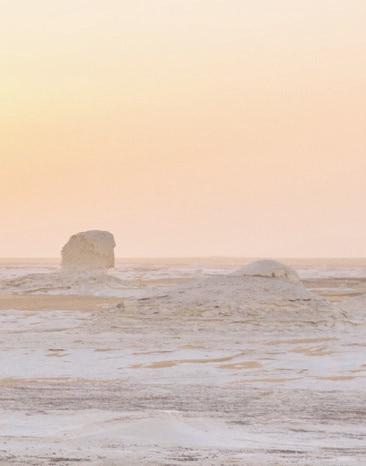














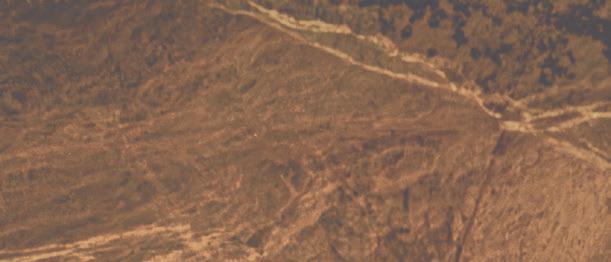


















CALL FOR AB STRACTS IS OPEN

31ST EUROPEAN MEETING OF

ENVIRONMENTAL AND ENGINEERING GEOPHYSICS

UXO AND OBJECT DETECTION
1ST CONFERENCE ON INFRASTRUCTURE PLANNING, MONITORING AND BIM
4TH CONFERENCE ON

6TH CONFERENCE ON
1ST CONFERENCE ON 7-11 SEPTEMBER 2025 | NAPLES, ITALY
MINERAL EXPLORATION AND MINING
GEOHAZARDS ASSESSMENT AND RISK MITIGATION
JOIN THE CONVERSATION AT EAGE NSG 2025!
This year, we’re spotlighting new topics in Geohazards Assessment & Risk Mitigation and UXO & Object Detection. Showcase your cutting-edge research and help drive the next wave of innovation in geoscience.
Maitena Daguerre1, Lubin Daumard1*, Emeline Di Pasquale1*, Quentin Garcin1 and Thibault Drulhe1
Introduction
The Minus CO2 Challenge brings together students from all over the world to tackle the challenges of the energy transition through geosciences. In 2024 17 teams participated. The topic was ‘Geothermal Electrical Power Generation in the Netherlands’.
The competition was driven by geological maps and data of the website NLOG: a regional-scale petroleum geological framework for the subsurface of the Netherlands generated by the Geological Survey of the Netherlands. It was also stimulated by an online news article from Mijnlieff (2020): ‘Introducing the geothermal play and reservoir geology of the Netherlands’. It was spurred by numerous reports of ThermoGIS, a geothermal energy information system developed by TNO (Netherlands Organisation for Applied Gesociences).
Congratulations to the five teams who prepared technical reports and gave excellent online presentations in the final round of the 2024 Minus CO2 Challenge in September. The GeoSquad team from UniLaSalle had the honour of presenting their work in person at the Global Energy Transition (GET) conference in Rotterdam in November 2024. Laura Valentina Socco, EAGE President, awarded the first prize (cf. Figure 1).
• First place: UniLaSalle, France
• Second place: Rajiv Gandhi Institute of Petroleum Technology, India
• Third place: University of Miskolc, Hungary
• Fourth place: IFP School, France
• Fifth place: University of Boumerdes, Algeria

The Netherlands has numerous geothermal resources. Currently, permeable geothermal aquifers are exploited with average temperatures between 40 and 100°C. Geothermal systems produce only heat for agricultural greenhouses, district heating and balneology (Mijnlieff, 2020). In 2019 geothermal energy provides just 0.6% of the total country’s heat demand (Peeters et al., 2021).
To increase the production and to develop geothermal electrical power generation, studies are in progress to determine suitable reservoirs for deep and ultra-deep geothermal energy. These types of geothermal energy require wells with depth between 1500 and 5000 m and temperatures above 120 °C (Peeters et al., 2021).
Reservoirs parameters for different geological formations have been summarised (cf. Table 1). The main characteristics that were looked at are thickness, depth, temperatures, transmissivity, permeability, geothermal systems already installed, and the associated type of energy produced.
The Netherlands disposes of several potential reservoirs in subsurface areas.
The Cenozoic is mainly composed of sandy and clayey-marl sediments and covers almost all of the Netherlands except the small areas of Limbourg and Twente. Despite all oil and gas wells drilled through this section, there is limited information on reservoir productivity and injectivity due to data acquisition that was left to a bare minimum (Mijnlieff, 2020).
The Upper Jurassic and Lower Cretaceous sedimentary sequences are predominantly composed of claystone and sandstone deposits (Mijnlieff, 2020).
Reservoirs of the Lower Cretaceous play are a primary target for hydrocarbon exploration and production and for geothermal reservoirs.
The Upper Jurassic play corresponds mainly to reservoirs of fluvial sandstones. The thickness of these formations is laterally highly variable (Mijnlieff, 2020).
The Buntsandstein Subgroup of the Lower Germanic Trias Group is composed of various sandstones. Despite their geothermal potential, the reservoir quality of these sandstones is not
1UniLaSalle
* Corresponding author, E-mail: lubin.daumard@gmail.com, dipasquale.emeline@gmail.com
well known and some authors identify diagenetic overprint as a notable exploration risk in the Netherlands (Bertier et al., 2022).
for
The Slochteren Formation of the Rotliegend Group (Permian) is a suitable reservoir geothermal application. It encompasses nearly the entire Dutch onshore. The Slochteren Sandstone Formation is composed of perennial lake, fluvial and alluvial sediments (Mijnlieff, 2020).
The Dinantian Limestones of the Lower Carboniferous present a faulted and fractured nature that facilitate hydrothermal fluid movement and karstification in the south of Netherlands. Consequently, geothermal production wells are located near the faulted and fractured Dinantian Limestones sequence, close to the Tegelen fault (Mijnlieff, 2020). On the contrary, the northern part presents several carbonate platform deposits. Three platforms are isolated and buried at sufficient depths to be considered as potential targets for UDG exploration (Bouroullec et al., 2019).
Below the Carboniferous, few wells penetrated the Devonian and are characterised by the tight sandstones and clays of the Bosscheveld formation (Mijnlieff, 2020).
The northern part of the Dinantian reservoir appears as the most suitable for electrical geothermal generation using a closed-loop system. This technology requires a formation with low porosity and permeability.
The northern part presents several carbonate platform deposits. Three platforms are isolated and buried at sufficient depths to be considered as potential targets for UDG exploration (cf. Figure 2). Their current heat flow and thickness confirm this hypothesis (Bouroullec et al., 2019).
However, these platforms may contain petrophysical anomalies interpreted as intra-Dinantian karstified or fractured systems (Gutteridge et al., 2025). This uncertainty must be taken into
account during the project, even if the coverage of Namurian shales prevented subsequent post-Namurian karstification from occurring (Mijnlieff, 2020).
Then, in order to select the most suitable zone and ensure production, wells of the Dinantian reservoir were studied. Three wells were highlighted: UHM-02, WSK-01 and LTG-01. This last well was selected for its optimal characteristics. The others were eliminated due to insufficient information, low temperatures or poor-quality reservoirs for AGS.
The LTG-01, a deep borehole of 5162 m depth, provides data on the Luttelgeest carbonate platform (cf. Figure 3). At the top of the platform, the temperature exceeds 150 °C and the conductivity is estimated around 4.0 W/m.K (Veldkamp and Hegen, 2020). At LTG-01, the platform has a thickness of 768 m and the platform’s top is located at a depth of 4355 m (Gutteridge et al., 2025). Some studies present the platform as intact, especially in the centre (Lipsey et al., 2016). Some fractures and karsts were revealed but are cemented (Bouroullec et al., 2019; Veldkamp and Hegen, 2020). At the LTG-01, the porosity and permeability are very low with an average porosity of 1 % (Carlson, 2019).
The platform is located under several cities and agricultural greenhouses that can be considered as potential users of the future produced energy. This makes the Luttelgeest platform suitable for electricity and heat production.
Closed-loop systems (AGS technology)
The Advanced Geothermal System (AGS) is an innovative technology based on a closed-loop system to facilitate heat transfer through a direct interaction between rock and working fluid. This project draws inspiration from the engineering principles of Eavor company. Here it uses two overlayed closed-loops: one at a depth of 4500 m (TVD) and the other at depth 4800 m (TVD). Each closed loop is composed of two vertical wells and 12 horizontal
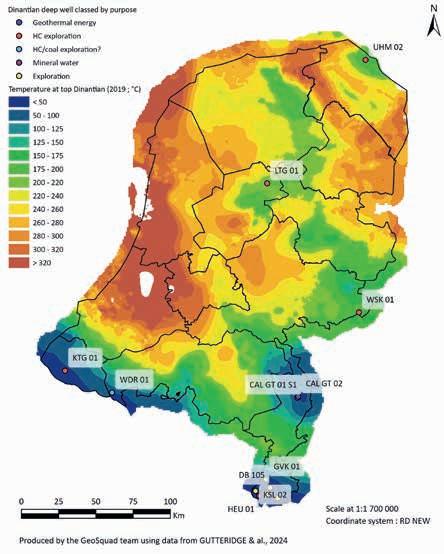
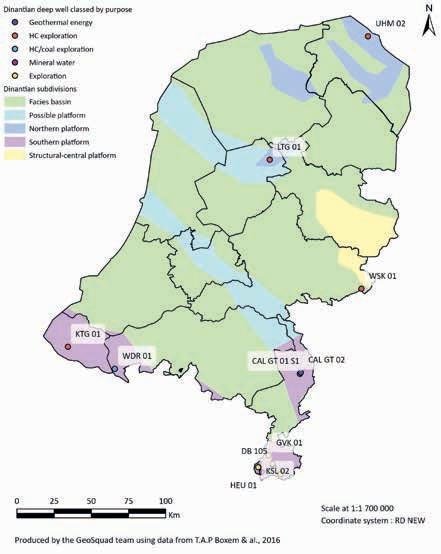
legs (cf. Figure 4). Each horizontal leg consists of two parallel wells connected at the end in order to shape mini-loops. This is achieved with magnetic ranging technology (Eavor, 2022). Furthermore, the Eavor’s Rock-Pipe technology enables us to directly seal the rock wall, allowing for efficient heat transfer through direct rock-fluid contact (Longfield, 2022). This is why these horizontal legs don’t need to be cased or cemented. Besides the circulation is powered by the thermosiphon effect (Longfield, 2022). In the injection well, the working fluid naturally goes down because it is cold and has a high density. At the bottom, it heats up by conduction from the surrounding rock, becomes less dense, and rises through the production well. This heated fluid will then be converted into electricity and warm water thanks to a power plant.
Design and development of a geothermal power plant
After heat recovery from the underground, the heat will be exchanged at the surface to create energy by an Organic Rankine Cycle power plant. The ORC circuit will use an organic fluid. First, this fluid will turn into steam thanks to a thermal energy exchange within a preheater and an evaporator, The steam will then move a turbine, which will create energy and electricity with a generator. After the turbine, the organic fluid will be condensed back into liquid, pumped, and the cycle will repeat. With the cogeneration system, the remaining heat will be recovered thanks to a second thermal energy exchange between a second circuit connected to the ORC circuit via a heat exchanger.
The estimated energy produced is around 4.4 gross MWe (3.6 net MWe) and 32.4 MWth. It will provide energy for approximately 10,000 households for towns like Emmeloord, which has 13,000 households. The heat could be distributed through a district heating network, and it could supply industries and towns around Luttelgeest. The installation should avoid around 24,000 CO2 equivalent tons per year.
Risk management, HSE, and monitoring
Risks in deep geothermal projects are numerous, but effective control measures can mitigate them. Before drilling, reservoir modelling is the essential first step in a project’s monitoring plan. This allows us to identify potential fractures, their ori-
entations, and any gas pockets. To achieve this, a 3D seismic survey combined with Formation Micro-Imager (FMI) logging is proposed to establish a Discrete Fracture Network (DFN). The 3D seismic survey provides a clear visualisation of subsurface structures and sedimentary layers, helping to interpret discontinuities such as fractures, while the FMI delivers critical data for characterising the wellbore and fracture orientations.
Additionally, well-logging techniques support reservoir modelling by assessing the risk of encountering gas pockets.
A comprehensive quality plan addresses major operational risks such as handling accidents, burns, and falling equipment. This plan also includes a preliminary impact study to assess ecosystem and groundwater safety, ensuring the project has no adverse impact on its natural environment.

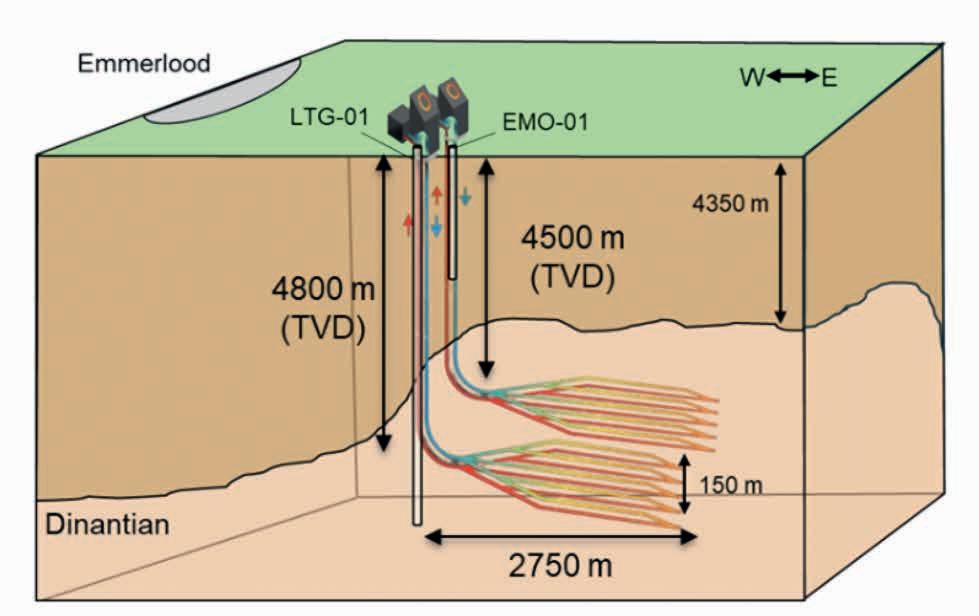

During operations, protocols outlined in the quality plan help to minimise risks. Continuous wellbore monitoring allows operators to implement preventive measures and enhance safety. Real-time parameters monitoring during drilling enables immediate adjustments to optimise the process and control potential hazards as they arise.
Finally, the risk of accidents is reduced by magnetic ranging techniques and the risk of induced seismicity is not a concern for this project, thanks to AGS technology.
Wellbore conditions will be monitored using integrated measurement platforms, enabling real-time tracking of drilling and intervention activities.
For well completions and production, various intervention techniques are planned, including chemical fluids like Rock-pipe, to optimise heat transfer.
A range of equipment, such as flow measurement tools, surface trees, and wellhead systems, will be implemented to ensure smooth operations.
Pressure and temperature will be closely monitored to maintain optimal conditions, and field service operators will be deployed to manage and maintain these installations.
For the project, an investment budget of 100 M€ was available. To assure the economic viability of the project and the respect of the budget, an estimation has been made.
The estimated capex includes the following costs categories:
• Exploration and data acquisition
• Drilling (vertical wells and lateral legs)
• Power plant
• Field gathering system
• Monitoring
The estimated budget was calculated according to three economic scenarios (standard, positive and negative) for horizontal drilling. Indeed, this type of drilling at great depths is relatively new and has some uncertainties about the costs.
At the end, the estimated capex is around 72 M€ for the standard scenario, 54 M€ for the positive scenario and 108 M€ for the negative scenario. The standard scenario will be used as a reference.
The drilling part represents the main costs, especially for the lateral legs drilling. For the standard scenario, it represents 21% of capex for vertical wells and 51% for horizontal legs, so a total of 72% (cf. Figure 5). These drilling costs for horizontal wells are based on a drilling scenario with a rate of penetration of 15 m/h and a bit life of around 50 hours. According to Beckers and Johnston (2022), these drilling characteristics were achieved in the FORGE project in Utah in 2021 at similar depths than the
potential project of AGS within the carbonate platform of Luttelgeest, and in crystalline rocks (Beckers and Johnston, 2022).
Then the Levelised Cost of Electricity (LCOE) and the Levelised Cost of Heat (LCOH) were determined according to Capex and Opex. It results in a LCOE of 150,9 €/MWh and a LCOH of 15,88 €/MWh.
Considering a project lifetime of 30 years and sales prices of 70 €/MWh e and 40 MW/hth, the total sales amount should be approximately 122 M€ higher than total production costs (cf. Figure 6).
It corresponds to an average profit of 4 M€/year. Although AGS is highly promising, the LCOE is still too high to be profitable on its own. However, the heat production is highly profitable. Thanks to the principle of cogeneration and the simultaneous production of electricity and heat, the project is profitable as a whole.
Moreover, the project is eligible for European subsidies like the Geretsried project wich received 91.6 M€ from the European Innovation Fund (EIF).
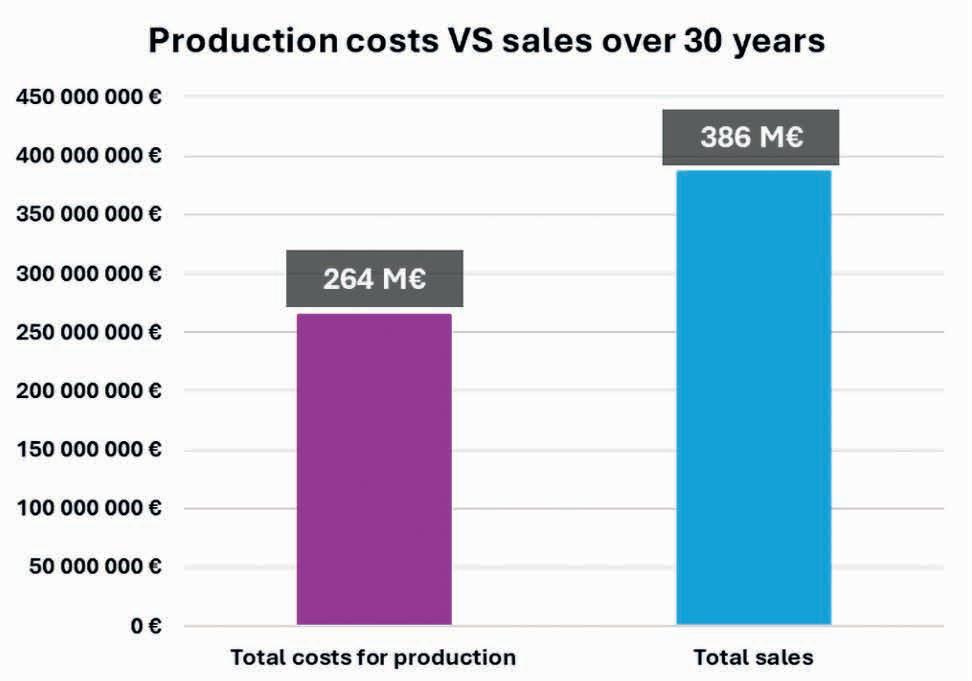

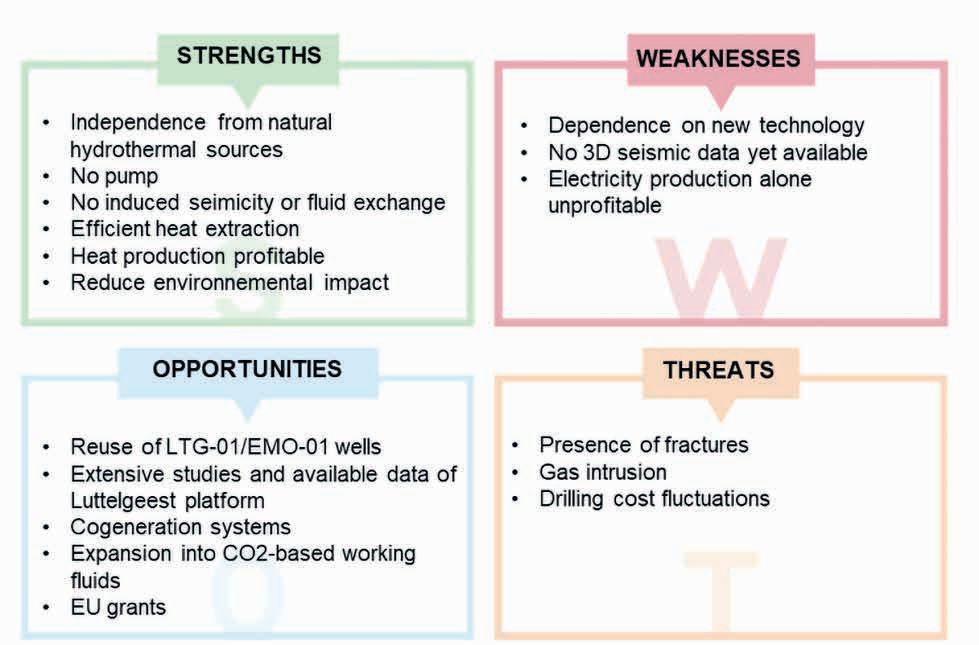
The project was classified according to the UNFC for Resources and its three criteria: Environmental-Socio-Economic Viability, Technical Feasibility and Degree of Confidence in geological knowledge. For each category, the project was classified with a score of 2 out of 3. It means that the project is potentially viable (cf. Figure 7).
Conclusion
A SWOT (Strengths, Weaknesses, Opportunities and Threats) analysis summarises well the project’s outlook (cf. Figure 8). It faces threats such as presence of fractures or karst, gas intrusion, and fluctuations in drilling costs. Some weaknesses include reliance on new technology, the lack of 3D seismic data, and the fact that electricity production alone may not be profitable.
However, key opportunities help to mitigate these issues, such as cost reductions achieved through the reuse of two existing wells, and improvement of the reservoir characterisation enabled by advanced modelling of the Luttelgeest platform. The project also has opportunities from a cogeneration system and potential use of CO2-based working fluids, with studies suggesting this could double the production efficiency even though further research is required.
The strengths of this project rely on its independence from natural hydrothermal sources, the absence of pumps or induced seismicity, and the absence of fluid exchange like in EGS systems.
References
Beckers, K.F., and Johnston, H.E. [2022]. Techno-Economic Performance of Eavor-Loop 2.0. 47th Workshop on Geothermal Reservoir Engineering, Proceedings.
Beckers, K.F., and McCabe, K. [2019]. GEOPHIRES v2.0: updated geothermal techno-economic simulation tool. Geothermal Energy, 7(1), 5. https://doi.org/10.1186/s40517-019-0119-6
Bertier, P., Swennen, R., Kemps, R., Laenen, B., and Dreesen, R. [2022]. Reservoir characteristics and diagenesis of the Buntsandstein sandstones in the Campine Basin (NE Belgium). Geologica Belgica, 25(3-4), 145-184. https://doi.org/10.20341/gb.2022.004
Bouroullec, R., Nelskamp, S., Kloppenburg, A., Abdul Fatah, R., Foeken, J., Ten Veen, J., Geel, K., Debacker, T., and Smit, J. [2019]. Burial and Structural Analysis of the Dinantian Carbonates in the Dutch Subsurface. Report for the SCAN program
Boxem, T.A.P., Veldkamp, J.G., and Van Wees, J.D.A.M. [2016]. Ultradiepe geothermie: Overzicht, inzicht & to-do ondergrond. TNO, Report 2016 R10803.
Carlson, T. [2019]. Petrophysical Report of the Dinantian Carbonates in the Dutch Subsurface. Report for the SCAN program, p. 22.
Eavor. [2021]. Eavor’s Ranging & Intersection. Retrieved from https:// www.youtube.com/watch?v=7Ig28shRjZA
Gutteridge, P., Ten Veen, J., Dewit, J., Garland, J., Riva, A., Mozafari, M., Jaarsma, B., and Van Melle, T. [2025]. Regional assessment of the ultra-deep geothermal (UDG) reservoir quality and potential of the Dinantian Zeeland Formation, the Netherlands. Geological Society, London, Special Publications, 548(1), SP548-2023–2106. https://doi. org/10.1144/SP548-2023-106
Lipsey, L., Pluymaekers, M., Goldberg, T., Van Oversteeg, K., Ghazaryan, L., Cloetingh, S., and Van Wees, J.-D. [2016]. Numerical modelling of thermal convection in the Luttelgeest carbonate platform, the Netherlands. Geothermics, 64, 135-151. https://doi.org/10.1016/j. geothermics.2016.05.002
Longfield, S., Schwarz, B., Hodder, M., Stuebing, T., Holmes, M., and Mölk, D. [2022]. Eavor LoopTM Commercial Project at Geretsried, Molasse Basin, Germany. European Geothermal Congress 2022, Conference Paper. https://www.researchgate.net/publication/366016670
Lowry, T.S., Finger, J.T., Carrigan, C.R., Foris, A., Kennedy, M.B., Corbet, T.F., Doughty, C.A., Pye, S., and Sonnenthal, E.L. [2017]. GeoVision Analysis Supporting Task Force Report: Reservoir Maintenance and Development. Sandia National Lab. (SNL-NM), Albuquerque, NM (United States).
Lowry, T.S., Foris, A., Finger, J.T., Pye, S., and Blankenship, D.A. [2017]. Implications of Drilling Technology Improvements on the Availability of Exploitable EGS Resources. 42nd Workshop on Geothermal Reservoir Engineering, Proceedings
Malek, A.E., Adams, B.M., Rossi, E., Schiegg, H.O., and Saar, M.O. [2022]. Techno-economic analysis of Advanced Geothermal Systems (AGS). Renewable Energy, 186, 927-943. https://doi.org/10.1016/j. renene.2022.01.012
Mijnlieff, H.F. [2020]. Introduction to the geothermal play and reservoir geology of the Netherlands. Netherlands Journal of Geosciences, 99(2). https://doi.org/10.1017/njg.2020.2
Mozafari, M., Gutteridge, P., Riva, A., Geel, K., Garland, J., and Dewit, J. [2019]. Facies analysis and diagenetic evolution of the Dinantian carbonates in the Dutch subsurface: overview and synthesis. Report for the SCAN program
Peeters, S.H.J., Mijnlieff, H.F., and Van Kempen, B.M.M. [2021]. Rapportage milieuhygiënische risico’s thermische vervuiling nabij geothermieputten. TNO
UNECE. [2019]. United Nations Framework Classification for Resources (UNFC). Retrieved 21 November 2024, from https://unece.org/ sustainable-energy/sustainable-resource-management/united-nations-framework-classification
Veldkamp, J.G., and Hegen, D. [2020]. Temperature modelling Dutch subsurface at depth Dinantian. Report for the SCAN program



February 2025
3-4 Feb EAGE Workshop on Carbon Capture and Storage (CCS) in Basalts www.eage.org
11 Feb Second EAGE Libyan Carbonates: Carbonate Geology and Its Role in Libya’s Exploration Success www.eage.org
17-19 Feb EGYPES 2025 www.egypes.com
18-20 Feb International Petroleum Technology Conference (IPTC) 2025 www.iptcnet.org
20-21 Feb GeoTHERM Expo & Congress 2025 www.geotherm-offenburg.de/en
26-28 Feb First EAGE Workshop on the Triassic and Jurassic Plays in Northwest Europe www.eage.org
March 2025
24-26 Mar 5 th EAGE Digitalization Conference and Exhibition www.eagedigital.org
April 2025
2-4 Apr 23 rd European IOR+ Symposium www.ior2025.org

13-16 Apr Innovative Technology for Reservoir Optimization: Fifth EAGE Well Injectivity & Productivity in Carbonates (WIPIC) Workshop www.eage.org
14-17 Apr International Scientific Conference on Monitoring of Geological Processes and Environmental Conditions www.eage.org


5-7
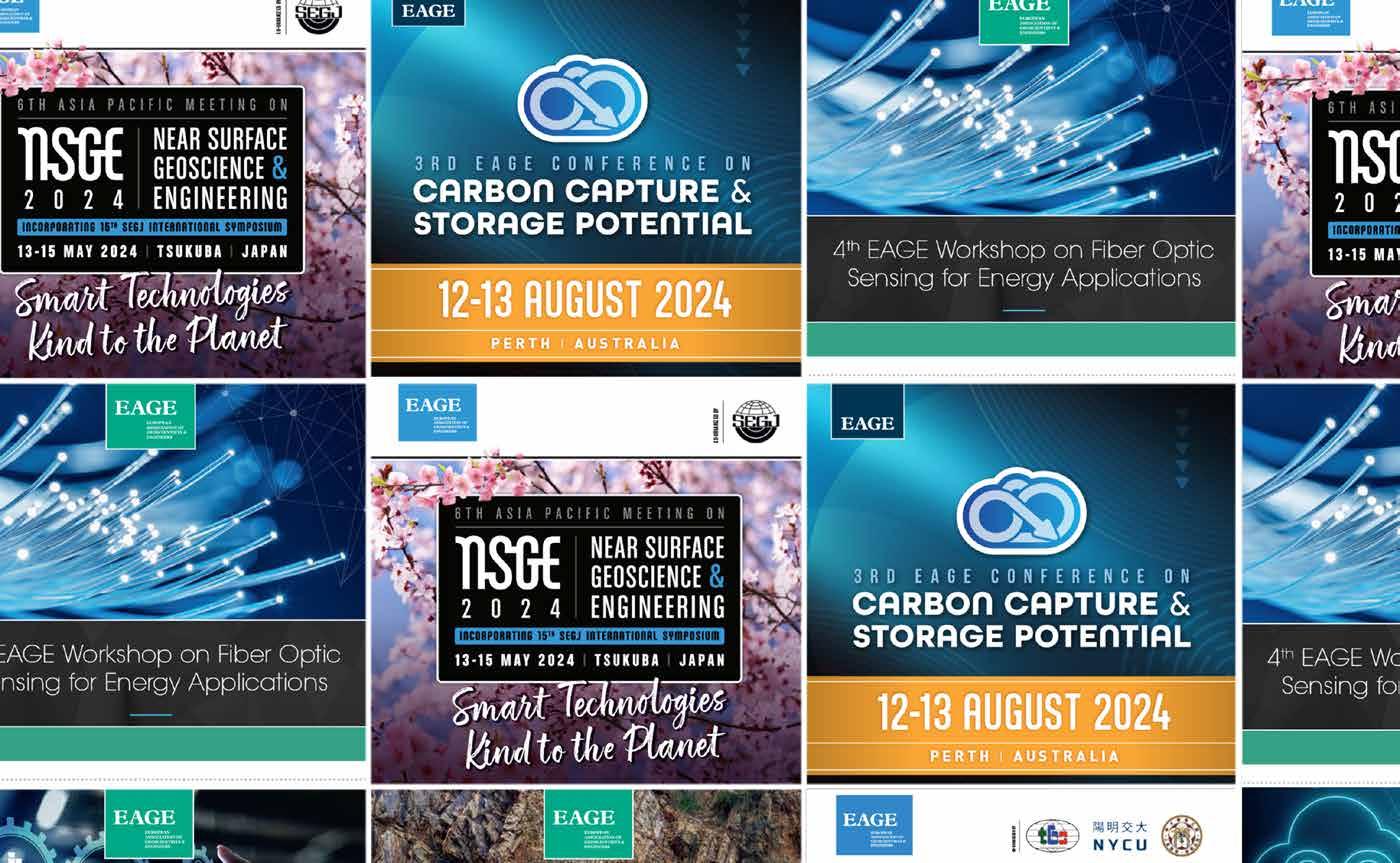





































































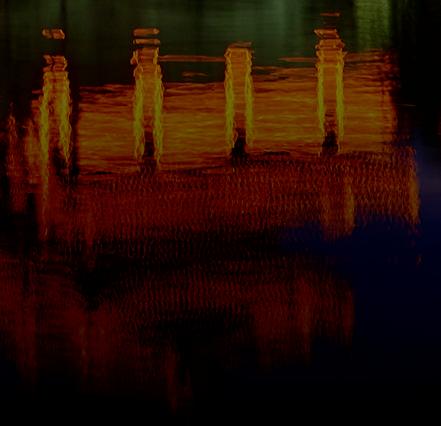

Engage with industry experts and researchers in a collaborative environment, exploring cutting-edge advancements shaping the future of near-surface geoscience and engineering. Register now to secure your spot at this premier event in scenic city of Xi'an, China!






















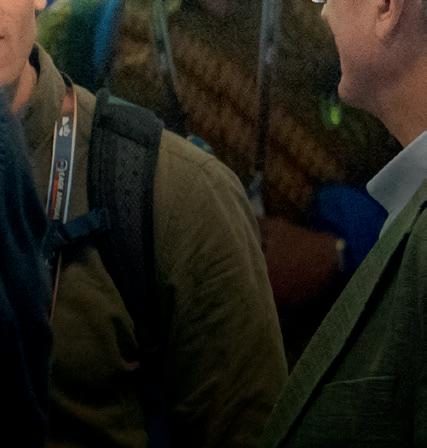






















Join the largest multidisciplinary geoscience and engineering event as we showcase the latest solutions in oil and gas, CCS, renewables and infrastructure geosciences. REGISTER NOW AT




































Technical & Strategic Programmes
Networking & Social Activities
Exhibition





Workshops, Field Trips & Courses

